-
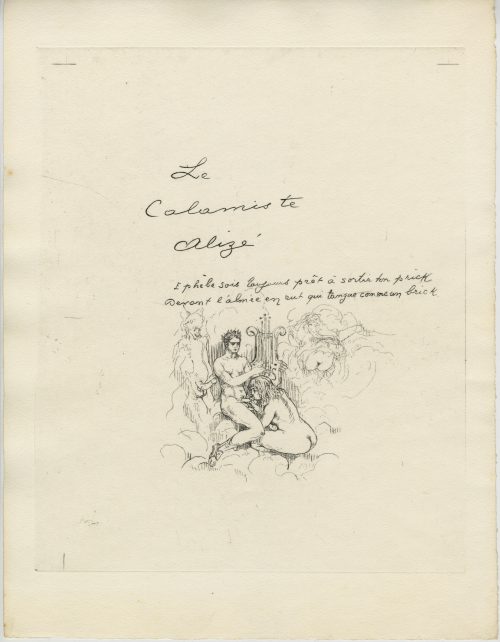 Thirteen unnumbered loose leaves 323 x 249 mm, watermarked BFK Rives, with manuscript text and vignettes produced by etching or, more likely, drypoint (see microphoto), incl. title-page, one full-page illustration and two leaves of text only; versos blank. Some leaves have registration marks. The set is housed in a cream French flapped folder (chemise) without lettering; the seller’s description is pasted to the front cover verso, glassine dust cover. Seller’s description: Cette édition in-folio du recueil de poèmes de Louis de Gonzague Frick, inconnue de Jean-Pierre Dutel, qui « a été tirée à 50 exemplaires (...) est certainement la plus rare (et a été) publiée après 1940 sur vélin (BFK) Rives » (cf. Ader, 3 mars 2020, n°155). Exemplaire « de passe », sans justificatif, complet des 13 planches avec 11 eaux-fortes, dont une à pleine page, d'Auguste Brouet. Ref.: According to honesterotica, the first edition was published in 1938 in 65 copies: "The pink Ingres paper and the loose-leaf format tied with a red ribbon". Another source states: "Le tirage a été effectué avec marges, sur papier vélin BFK Rives au format in-4 (32,5 × 25), les planches mesurant 26,5 × 22 cm. Certains exemplaires sont sur papier blanc - Je remercie le libraire qui a pris la peine de me communiquer ces dernières informations. Pour moi, c'est bien l'édition à 65 qui est l'originale, les deux autres étant des retirages légèrement postérieurs, mais dans le détail desquels le principe de l’œuvre - un manuscrit destiné à quelques amis de l'auteur - a été quelque peu trahi." Contributors: Louis de Gonzague Frick (French, 1883 – 1958) Auguste Brouet (French, 1872 – 1941)
Thirteen unnumbered loose leaves 323 x 249 mm, watermarked BFK Rives, with manuscript text and vignettes produced by etching or, more likely, drypoint (see microphoto), incl. title-page, one full-page illustration and two leaves of text only; versos blank. Some leaves have registration marks. The set is housed in a cream French flapped folder (chemise) without lettering; the seller’s description is pasted to the front cover verso, glassine dust cover. Seller’s description: Cette édition in-folio du recueil de poèmes de Louis de Gonzague Frick, inconnue de Jean-Pierre Dutel, qui « a été tirée à 50 exemplaires (...) est certainement la plus rare (et a été) publiée après 1940 sur vélin (BFK) Rives » (cf. Ader, 3 mars 2020, n°155). Exemplaire « de passe », sans justificatif, complet des 13 planches avec 11 eaux-fortes, dont une à pleine page, d'Auguste Brouet. Ref.: According to honesterotica, the first edition was published in 1938 in 65 copies: "The pink Ingres paper and the loose-leaf format tied with a red ribbon". Another source states: "Le tirage a été effectué avec marges, sur papier vélin BFK Rives au format in-4 (32,5 × 25), les planches mesurant 26,5 × 22 cm. Certains exemplaires sont sur papier blanc - Je remercie le libraire qui a pris la peine de me communiquer ces dernières informations. Pour moi, c'est bien l'édition à 65 qui est l'originale, les deux autres étant des retirages légèrement postérieurs, mais dans le détail desquels le principe de l’œuvre - un manuscrit destiné à quelques amis de l'auteur - a été quelque peu trahi." Contributors: Louis de Gonzague Frick (French, 1883 – 1958) Auguste Brouet (French, 1872 – 1941) -
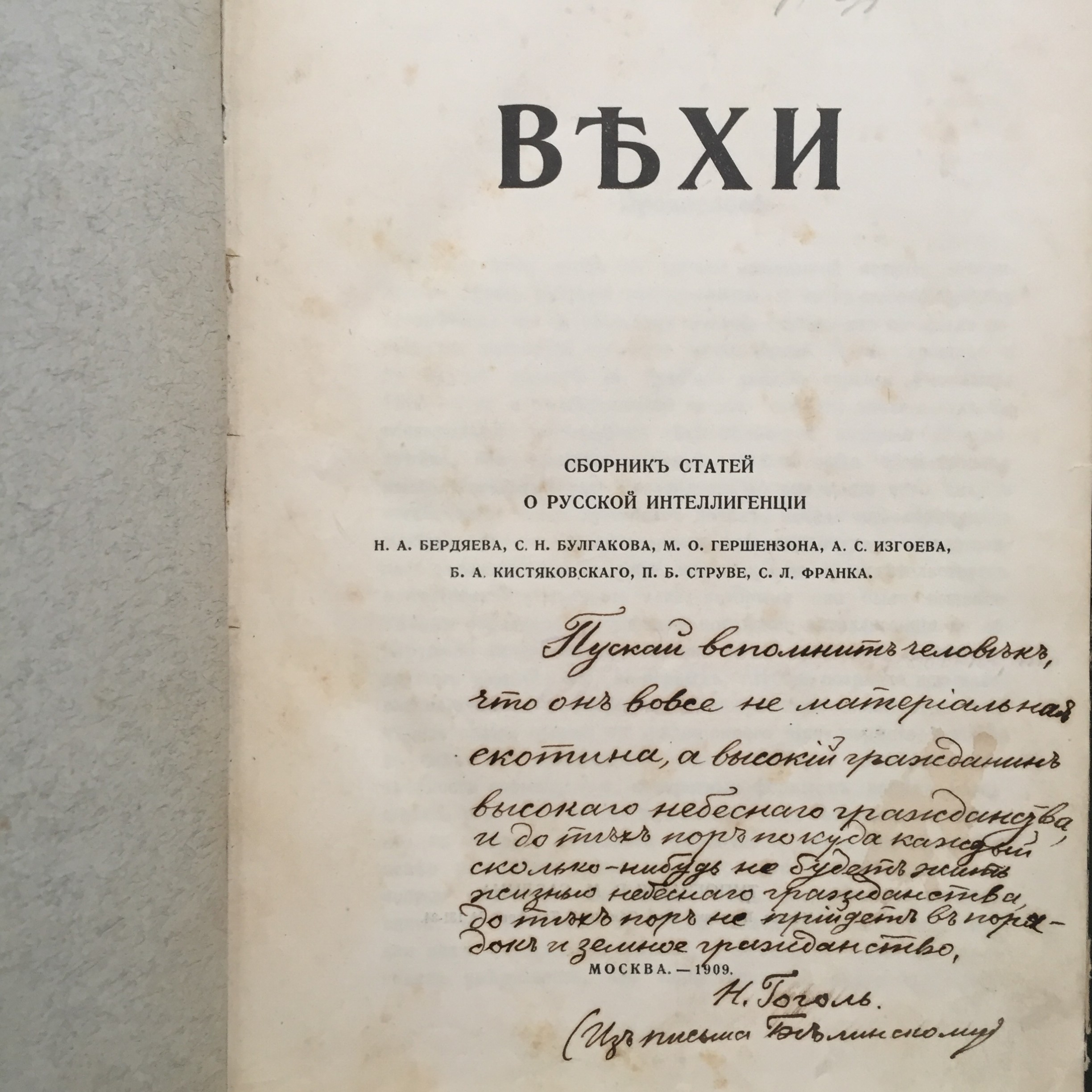
Вехи. Сборник статей о русской интеллигенции. Москва, 1909. Типография В. М. Саблина.
Предисловие. М. О. Гершензон. Н. А. Бердяев. Философская истина и интеллигентская правда. С. Н. Булгаков. Героизм и подвижничество. М. О. Гершензон. Творческое самосознание. Б. А. Кистяковский. В защиту права. П. Б. Струве. Интеллигенция и революция. С. Л. Франк. Этика нигилизма. А. С. Изгоев. Об интеллигентной молодежи. -

Fuchi-kashira made of shakudō carved and inlaid with gold and red copper with the design of a bat and a fruit (persimmon?). Nanako surface.
Fuchi: 37 x 19 x 7 mm. Kashira: 34 x 16 x 5 mm. Main material: shakudō. Other metals: gold and copper. Surface treatment: nanako-ji. -
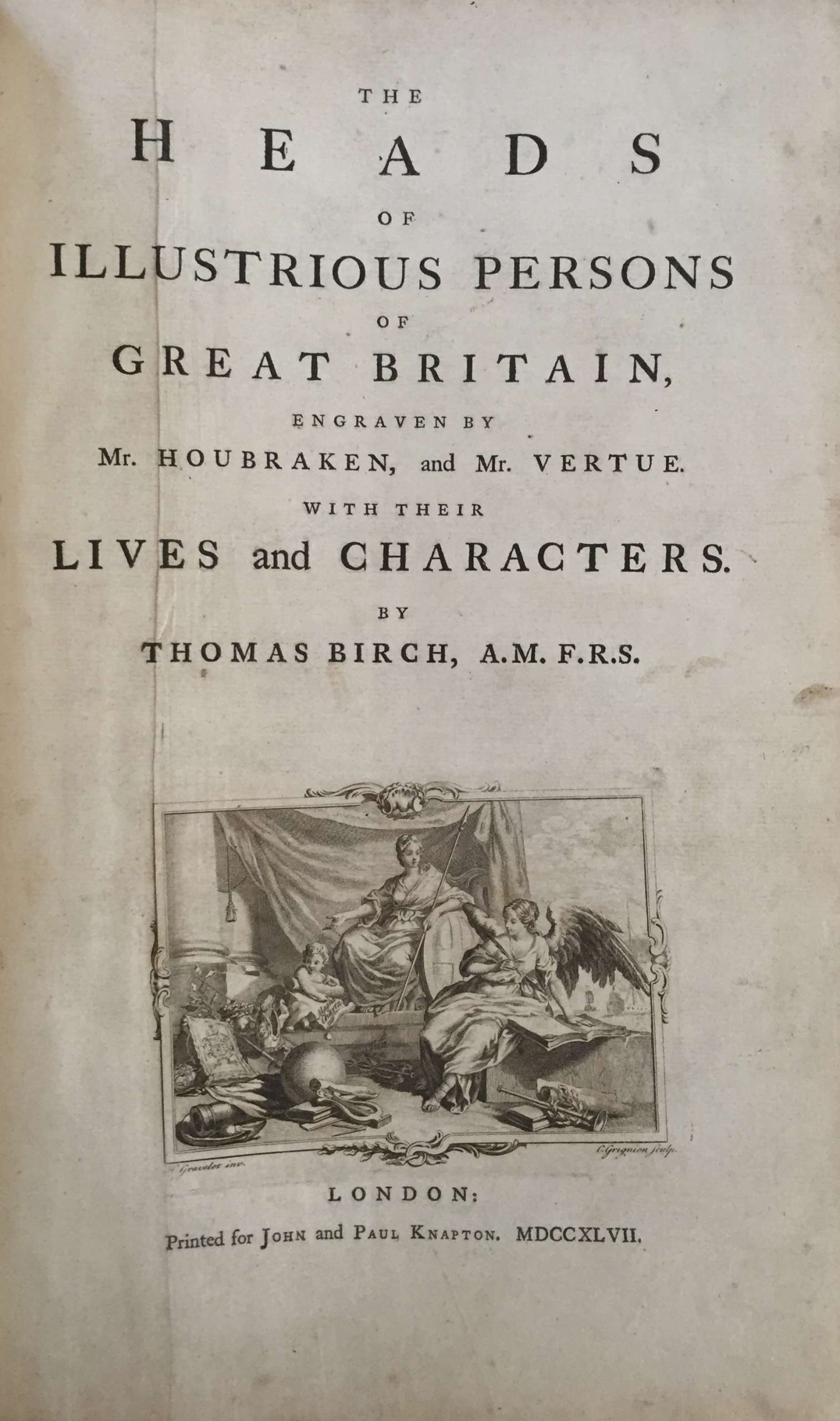
The Heads of Illustrious Persons of Great Britain Engraven By Mr. Houbraken And Mr. Vertue. With Their Lives And Characters by Thomas Birch, A.M.F.R.S. Two Volumes in One. Published for John and Paul Knapton, London, 1747. 108 engraved portraits.
-
 Iron tsuba of round form with design of triple diamond (matsukawa-bishi) in openwork (sukashi). Square rim. Ko-Tosho school. Nanbokucho period: Late 14th century (Oan/Eiwa era). Height: 92.3 mm. Width: 92.3 mm. Rim thickness: 2.5 mm. Center thickness: 3.0 mm. Provenance: Sasano Masayuki Collection, № 15: "Two small lozenges are attached to each end of a larger lozenge. Most Ko-tosho tsuba have inspirational designs, however this has a rather casual appearance, although it represents the unstable political situation at the time".
Iron tsuba of round form with design of triple diamond (matsukawa-bishi) in openwork (sukashi). Square rim. Ko-Tosho school. Nanbokucho period: Late 14th century (Oan/Eiwa era). Height: 92.3 mm. Width: 92.3 mm. Rim thickness: 2.5 mm. Center thickness: 3.0 mm. Provenance: Sasano Masayuki Collection, № 15: "Two small lozenges are attached to each end of a larger lozenge. Most Ko-tosho tsuba have inspirational designs, however this has a rather casual appearance, although it represents the unstable political situation at the time". -
 Iron tsuba of round form with design of rabbit (usagi) in openwork (sukashi) and inlaid with designs of plants and family crests (mon) in suemon-zōgan. A branch with lonely leaf, half chrysanthemum, and flying wild geese on the face represent autumnal connotations. The same motif is complemented by a clove (choji) on the reverse. The family crests (mon) include: interlocked rings (kanawa; wachigai), three encircled lines or stripes (hikiryo), bit or muzzle (kutsuwa - horse's harness element with possible christian symbolism), and encircled triangle (uroko, fish scale). Brass wire trim around the openwork elements and the seppa-dai, scalloped wire inlay around the hitsu-ana. Iron is dark, almost black. Brass or copper elements vary in shades of lighter and darker yellow with red-ish hue. Ōnin school. Late Muromachi period, 16th century. Height: 89.6 mm; Width: 89.3 mm; Thickness at seppa-dai: 3.0 mm. Weight: 129.7 g.
Iron tsuba of round form with design of rabbit (usagi) in openwork (sukashi) and inlaid with designs of plants and family crests (mon) in suemon-zōgan. A branch with lonely leaf, half chrysanthemum, and flying wild geese on the face represent autumnal connotations. The same motif is complemented by a clove (choji) on the reverse. The family crests (mon) include: interlocked rings (kanawa; wachigai), three encircled lines or stripes (hikiryo), bit or muzzle (kutsuwa - horse's harness element with possible christian symbolism), and encircled triangle (uroko, fish scale). Brass wire trim around the openwork elements and the seppa-dai, scalloped wire inlay around the hitsu-ana. Iron is dark, almost black. Brass or copper elements vary in shades of lighter and darker yellow with red-ish hue. Ōnin school. Late Muromachi period, 16th century. Height: 89.6 mm; Width: 89.3 mm; Thickness at seppa-dai: 3.0 mm. Weight: 129.7 g. -
 Richard Parkes Bonington (1802–1828 ). British/French. Evreux: Tour du Gros Horloge (Evreux: Large Clock Tower). Inscription: The tower was built in 1417 when the area was ruled by England. Lithograph. From the Taylor and Nodier set "Normandie", Vol. II, pl. 226. 1824. MET# 22.87.2. Catalogue Raisonné: Curtis 1939, no. 19. MET description: "This view in the French town of Evreux focuses on the clock tower, with vendors and customers in the street below. Bonington produced the print for the multi-volume series directed by Baron Isidore Taylor, Charles Nodier and Alphonse de Cailleux titled "Voyages Pittoresques et Romantiques dans l'Ancienne France" (Picturesque and Romantic Travels through Historic France). This image appears in volume 2, devoted to Normandy."
Richard Parkes Bonington (1802–1828 ). British/French. Evreux: Tour du Gros Horloge (Evreux: Large Clock Tower). Inscription: The tower was built in 1417 when the area was ruled by England. Lithograph. From the Taylor and Nodier set "Normandie", Vol. II, pl. 226. 1824. MET# 22.87.2. Catalogue Raisonné: Curtis 1939, no. 19. MET description: "This view in the French town of Evreux focuses on the clock tower, with vendors and customers in the street below. Bonington produced the print for the multi-volume series directed by Baron Isidore Taylor, Charles Nodier and Alphonse de Cailleux titled "Voyages Pittoresques et Romantiques dans l'Ancienne France" (Picturesque and Romantic Travels through Historic France). This image appears in volume 2, devoted to Normandy." -
 Iron tsuba of mokko form with slanting rays of light (shakoh) Christian motif (Jesuit's IHS symbol) in openwork (sukashi). Traditional description of this kind of design is called "tokei", or "clock gear". Owari school. Edo period.
Iron tsuba of mokko form with slanting rays of light (shakoh) Christian motif (Jesuit's IHS symbol) in openwork (sukashi). Traditional description of this kind of design is called "tokei", or "clock gear". Owari school. Edo period.Size: 83.4 x 83.1 x 4.4 mm
NTHK certified KANTEISHO ("Important Work"). In a custom wooden box. For information regarding shakoh tsuba see article 'Kirishitan Ikenie Tsuba by Fred Geyer at Kokusai Tosogu Kai; The 2nd International Convention & Exhibition, October 18-23, 2006, pp. 84-91. -
 Iron tsuba of round form decorated with dragonfly (tombo) and comma (comma-like swirl, tomoe) in openwork (sukashi) outlined with brass wire. The plate decorated with 5 concentric circular rows of brass dots in ten-zōgan. Center of the plate outlined with the inlaid circular brass wire (sen-zōgan). Ōnin school. Unsigned. Mid Muromachi period, middle of the 15th century. Dimensions: Diameter: 89.5 mm, thickness: 3.1 mm. Notes regarding design: "According to various sources, the dragonfly (tombo) is emblematic of martial success, as various names for the insect are homophones for words meaning "victory". The dragonfly is also auspicious because references in the Kojiki and Nihongi link it in both name and shape to the old kingdom of Yamato." [Merrily Baird. Symbols of Japan. Thematic motifs in art and design. Rizzoli international publications, Inc., 2001, p. 108]. "The dragonfly (tonbo), was also called kachimushi in earlier times, and due to the auspicious literal meaning "victory bug" of the characters of this word it became a popular theme on sword fittings." [Iron tsuba. The works of the exhibition "Kurogane no hana", The Japanese Sword Museum, 2014, p. 13]. Helen C. Gunsaulus' description of the dragonfly emblem is as follows: "This motive, the dragon-fly (akitsu), is generally accepted as a symbol of the kingdom of Japan, and the origin of the idea is traced to the legend recounted in the Kojiki and Nihongo of the Emperor Jimmu's view of the island from mountain top. He is said to have thought the kingdom looked like a dragon-fly touching its tail with its mouth. From this it received its name Akitsu-shima... etc."
Iron tsuba of round form decorated with dragonfly (tombo) and comma (comma-like swirl, tomoe) in openwork (sukashi) outlined with brass wire. The plate decorated with 5 concentric circular rows of brass dots in ten-zōgan. Center of the plate outlined with the inlaid circular brass wire (sen-zōgan). Ōnin school. Unsigned. Mid Muromachi period, middle of the 15th century. Dimensions: Diameter: 89.5 mm, thickness: 3.1 mm. Notes regarding design: "According to various sources, the dragonfly (tombo) is emblematic of martial success, as various names for the insect are homophones for words meaning "victory". The dragonfly is also auspicious because references in the Kojiki and Nihongi link it in both name and shape to the old kingdom of Yamato." [Merrily Baird. Symbols of Japan. Thematic motifs in art and design. Rizzoli international publications, Inc., 2001, p. 108]. "The dragonfly (tonbo), was also called kachimushi in earlier times, and due to the auspicious literal meaning "victory bug" of the characters of this word it became a popular theme on sword fittings." [Iron tsuba. The works of the exhibition "Kurogane no hana", The Japanese Sword Museum, 2014, p. 13]. Helen C. Gunsaulus' description of the dragonfly emblem is as follows: "This motive, the dragon-fly (akitsu), is generally accepted as a symbol of the kingdom of Japan, and the origin of the idea is traced to the legend recounted in the Kojiki and Nihongo of the Emperor Jimmu's view of the island from mountain top. He is said to have thought the kingdom looked like a dragon-fly touching its tail with its mouth. From this it received its name Akitsu-shima... etc." -
 Untrimmed fan print (uchiwa-e), 231 x 300 mm. Title: A geisha eating edamame aboard the boat of the Atari-ya teahouse. Series: Three summer women [九夏三婦久] (Kyūka sanfuku). Artist: Utagawa Kunisada [歌川 国貞] a.k.a. Utagawa Toyokuni III [三代歌川豊国] (Japanese, 1786 – 1865). Artist: Utagawa Kunihisa II [歌川国久] a.k.a. Katsuda Hisatarō, Ichiunsai, Ritchōrō, Toyonobu, Yōryūsai, Yōsai] (Japanese, 1832 – 1981). Block cutter: Yokokawa Horitake [横川彫武] a.k.a. Yokokawa Takejiro [横川竹二郎] (Japanese, fl. 1860s). Publisher: Ibaya Senzaburō [伊場屋仙三郎] (Japanese, fl. C. 1845 – 1847) Combined date seal and kiwame censor seal: 1860 (Ansei 7 / Man'en 1 from 18/III). Signed: Toyokuni ga in toshidama cartouche, and Kunihisa ga. Provenance: The Collection of Paul F. Walter, Christie's, New York, 2017, lot 341; sol together with 5 other fan prints for $25,000. Before: Israel Goldman, Japanese Prints, Catalogue 9, 2003, no. 35. Ref: [LIB-1693.2018] The Collection of Paul Walter. — NY: Christie's, 2017, p. 363. Ref: Israel Goldman, Catalogue 2018, № 52: "Utagawa Kunisada (1786-1865) and Utagawa Kunihisa II (1832-1891) A Geisha Eating Edamame Aboard the Boat of the Atari-ya Teahouse. From the series Kyuka sanfuku (Three Summer Women). 1860. Fan print. 22.7 x 29.6 cm. Provenance: Israel Goldman, Japanese Prints, Catalogue 9, 2003, no. 35. The Collection of Paul F. Walter, Christies, New York, 201, lot 341. Fine impression, colour and condition. The title is a pun on “kyuka sanpuku” meaning the hottest point of the summer. The background view is by Kunisada’s pupil Kunihisa."
Untrimmed fan print (uchiwa-e), 231 x 300 mm. Title: A geisha eating edamame aboard the boat of the Atari-ya teahouse. Series: Three summer women [九夏三婦久] (Kyūka sanfuku). Artist: Utagawa Kunisada [歌川 国貞] a.k.a. Utagawa Toyokuni III [三代歌川豊国] (Japanese, 1786 – 1865). Artist: Utagawa Kunihisa II [歌川国久] a.k.a. Katsuda Hisatarō, Ichiunsai, Ritchōrō, Toyonobu, Yōryūsai, Yōsai] (Japanese, 1832 – 1981). Block cutter: Yokokawa Horitake [横川彫武] a.k.a. Yokokawa Takejiro [横川竹二郎] (Japanese, fl. 1860s). Publisher: Ibaya Senzaburō [伊場屋仙三郎] (Japanese, fl. C. 1845 – 1847) Combined date seal and kiwame censor seal: 1860 (Ansei 7 / Man'en 1 from 18/III). Signed: Toyokuni ga in toshidama cartouche, and Kunihisa ga. Provenance: The Collection of Paul F. Walter, Christie's, New York, 2017, lot 341; sol together with 5 other fan prints for $25,000. Before: Israel Goldman, Japanese Prints, Catalogue 9, 2003, no. 35. Ref: [LIB-1693.2018] The Collection of Paul Walter. — NY: Christie's, 2017, p. 363. Ref: Israel Goldman, Catalogue 2018, № 52: "Utagawa Kunisada (1786-1865) and Utagawa Kunihisa II (1832-1891) A Geisha Eating Edamame Aboard the Boat of the Atari-ya Teahouse. From the series Kyuka sanfuku (Three Summer Women). 1860. Fan print. 22.7 x 29.6 cm. Provenance: Israel Goldman, Japanese Prints, Catalogue 9, 2003, no. 35. The Collection of Paul F. Walter, Christies, New York, 201, lot 341. Fine impression, colour and condition. The title is a pun on “kyuka sanpuku” meaning the hottest point of the summer. The background view is by Kunisada’s pupil Kunihisa." -
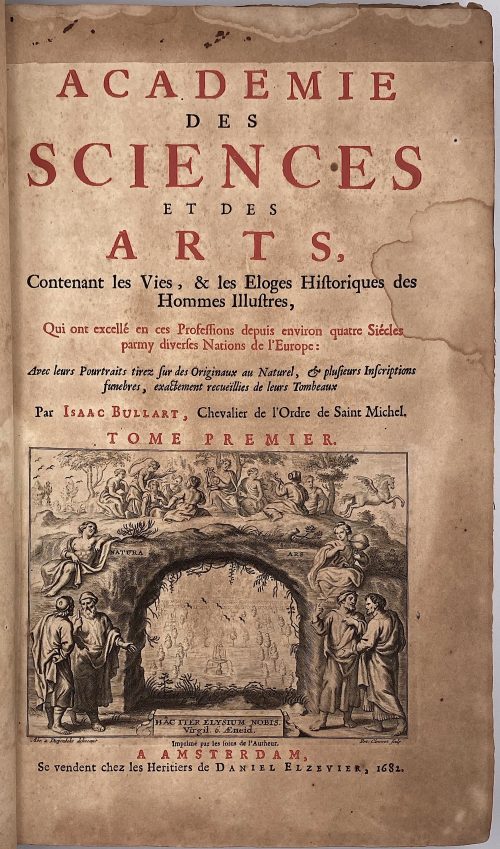 Title: ACADEMIE | DES | SCIENCES | ET DES | ARTS, | Contenant les Vies & les Eloges Historiques des | Hommes Illustres, | Qui ont excellé en ces Professions depuis environ quatre Siécles | parmy diverses Nations de l’Europe : |Avec leurs Pourtraits tirez sur des Originaux au Naturel, & plusieurs Inscriptions | funebres, exactement recueïlies de leurs Tombeaux | Par Isaac Bullart , Chevalier de l’Ordre de Saint Michel. | TOME PREMIER | {allegorical vignette, signed Abr. A Diepenbeke delineavit – Pet. Clouwet sculp.} | Imprimé par les soins de l’Autheur. | A AMSTERDAM, | Se vendent chez les Heritiers de Daniel Elzevier, 1682. || Pagination : [2] – h.t. / blank ; [2] – 1st vol. t.p. in black and red with vignette engraved by Pet. Clouwet after Abr. Diepenbeke / blank; [7] – dedication to Jacques Theodore de Brias {Jacques-Théodore de Bryas (Dutch, 1630 – 1694)}, [9] – preface, [2] – table demonstrative / stanza by Guilielmus Riverius, [2] vinette “Tardius sed grandius” with an elephant in ornamental frame / text; [2] – Advis au lecteur; [1, 2] – f.t. livre premiere, illustres politiques / blank; [2] – noms politiques / blank (A1, after f.t.), 3(A2)-421, [422-424] – table eloges. Collation: [*]6, **8, A6 B-Ggg4. (14 prelim. leaves, as in LIB-2675.2021; the LIB-2676.2021 copy has 12) Binding: 34.5 x 22 x 4.3 cm.34.5 x 22 x 4.3 cm, hardbound; full calf, raised bands. The title is drawn by Abraham van Diepenbeeck (Dutch, 1596 - 1675) and engraved by Peeter Clouwet (Flemish, 1629–1670). The first volume of a two-volume set contains 119 copperplate burin-engraved portraits of selected politicians, historians, jurists, writers, and Italian artists. 26 portraits engraved by Esme de Boulonois (French,1645 – 1681), 3 unsigned, and the rest engraved by Nicolas de Larmessin I (French, 1632 – 1694)Lavinia Vecellio, (Italian, 1530 – 1575), Titian' daughter, engraved by Lamerssin after Titian, Portrait of Jacques Auguste de Thou engraved by de Boulonois after Daniel Dumonstier. Politicians: Antoine Perrenot, Cardinal de Granvelle; Arnaud d'Ossat, Cardinal; Auger Busbeque; Bessarion, Cardinal; François Ximenes, Cardinal; George d'Amboise, Cardinal; Gille Albornoz, Cardinal; Guillaume de Croy; Guy du Faur de Pybrac; Jacques Auguste de Thou; Jean de Selve; Jean Zamoski; Jean de Barnevelt; Jean Armand du Plessis, Cardinal de Richelieu; Jule Mazarin, Cardinal; Michel de l'Hospital; Renaud Pole, Cardinal; Stanislas Hosius, Cardinal; Thomas Morus; Thomas Wolsey, Cardinal. Historians: Bertrand d'Argentré; Cæsar Baronius, Cardinal; Emanuel de Meteren; Enguerand de Monstrelet; Florimond de Remond; François Guicciardin; Fulve Ursin; Guillaume Camden; Henry Catherine d'Avila; Hubert Goltzius; Jacques Amiot; Jean Aventin; Jean Baptiste Platina; Jean Barclay; Jean Froissard; Jean Papirius Masson; Nicolas le Febure; Olivier de la Marche; Onuphre Panuinius; Pandolphe Collenuce; Paul Jove; Philippe de Commines; Pontus Heuterus; Regino Abbé de Prumy; Robert Gaguin; Wolfgang Lazius. Jurists: Alexandre de Tartagnis; André Alciat; André Tiraqueau; Antoine Augustin; Antoine le Febvre; Boece Epo; Charles du Moulin; François Bauduin; Gabriel Mudée; Jacques Cuias; Jason Mainus; Jean Wamese; Mathieu Wesenbec; Philippe Dece; Pierre Peckius; Pierre Pithou; Tibere Decian; Viglius de Zuichem. Writers/Linguists: Ange Politian; Demetrius Chalcondyles; Emanuel Chrysoloras; François Philelphe; François Raphelenge; Guillaume Postel; Jean Argyropilus; Jean Bocace; Jean Lascaris; Jean Passerat; Jean Pierius Valerianus; Jeanne Gray; Nicolas Clenard; Pierre Nannius; Rudolphe Agricola; Theodore Gaza. Italian painters, architects, and sculptors: André Mantegna; André Organa; André del Sarto; André Tafi; André Verrochio; Antoine de Correge; Antoine de Messine; Arnoud di Lappo; Baccio Bandinel; Balthazar Perusi; Bramante d'Urbin; Daniel Ricciarelli; Dominique Beccafumi; Donato; François Mazzuoli; François Primatici; Frere Philippe Lippi; Giorgion; Giotto; Jacques Barozzi de Vignole; Jean Antoine Licinio de Pordenone; Jean Cimabue; Jean d'Udine; Jean François Rustici; Jule Romain; Le Rosso; Leonard de Vinci; Masaccio; Michel-Ange Buonarotti; Perin del Vaga; Philippe Bruneleschi; Philippe Lippi; Polidore de Caravage; Propertia de Rossi; Raphael Sanzio d'Urbin; Sandro Boticelli; Simon Memmi; Taddée Gaddi; Titian Uccello.
Title: ACADEMIE | DES | SCIENCES | ET DES | ARTS, | Contenant les Vies & les Eloges Historiques des | Hommes Illustres, | Qui ont excellé en ces Professions depuis environ quatre Siécles | parmy diverses Nations de l’Europe : |Avec leurs Pourtraits tirez sur des Originaux au Naturel, & plusieurs Inscriptions | funebres, exactement recueïlies de leurs Tombeaux | Par Isaac Bullart , Chevalier de l’Ordre de Saint Michel. | TOME PREMIER | {allegorical vignette, signed Abr. A Diepenbeke delineavit – Pet. Clouwet sculp.} | Imprimé par les soins de l’Autheur. | A AMSTERDAM, | Se vendent chez les Heritiers de Daniel Elzevier, 1682. || Pagination : [2] – h.t. / blank ; [2] – 1st vol. t.p. in black and red with vignette engraved by Pet. Clouwet after Abr. Diepenbeke / blank; [7] – dedication to Jacques Theodore de Brias {Jacques-Théodore de Bryas (Dutch, 1630 – 1694)}, [9] – preface, [2] – table demonstrative / stanza by Guilielmus Riverius, [2] vinette “Tardius sed grandius” with an elephant in ornamental frame / text; [2] – Advis au lecteur; [1, 2] – f.t. livre premiere, illustres politiques / blank; [2] – noms politiques / blank (A1, after f.t.), 3(A2)-421, [422-424] – table eloges. Collation: [*]6, **8, A6 B-Ggg4. (14 prelim. leaves, as in LIB-2675.2021; the LIB-2676.2021 copy has 12) Binding: 34.5 x 22 x 4.3 cm.34.5 x 22 x 4.3 cm, hardbound; full calf, raised bands. The title is drawn by Abraham van Diepenbeeck (Dutch, 1596 - 1675) and engraved by Peeter Clouwet (Flemish, 1629–1670). The first volume of a two-volume set contains 119 copperplate burin-engraved portraits of selected politicians, historians, jurists, writers, and Italian artists. 26 portraits engraved by Esme de Boulonois (French,1645 – 1681), 3 unsigned, and the rest engraved by Nicolas de Larmessin I (French, 1632 – 1694)Lavinia Vecellio, (Italian, 1530 – 1575), Titian' daughter, engraved by Lamerssin after Titian, Portrait of Jacques Auguste de Thou engraved by de Boulonois after Daniel Dumonstier. Politicians: Antoine Perrenot, Cardinal de Granvelle; Arnaud d'Ossat, Cardinal; Auger Busbeque; Bessarion, Cardinal; François Ximenes, Cardinal; George d'Amboise, Cardinal; Gille Albornoz, Cardinal; Guillaume de Croy; Guy du Faur de Pybrac; Jacques Auguste de Thou; Jean de Selve; Jean Zamoski; Jean de Barnevelt; Jean Armand du Plessis, Cardinal de Richelieu; Jule Mazarin, Cardinal; Michel de l'Hospital; Renaud Pole, Cardinal; Stanislas Hosius, Cardinal; Thomas Morus; Thomas Wolsey, Cardinal. Historians: Bertrand d'Argentré; Cæsar Baronius, Cardinal; Emanuel de Meteren; Enguerand de Monstrelet; Florimond de Remond; François Guicciardin; Fulve Ursin; Guillaume Camden; Henry Catherine d'Avila; Hubert Goltzius; Jacques Amiot; Jean Aventin; Jean Baptiste Platina; Jean Barclay; Jean Froissard; Jean Papirius Masson; Nicolas le Febure; Olivier de la Marche; Onuphre Panuinius; Pandolphe Collenuce; Paul Jove; Philippe de Commines; Pontus Heuterus; Regino Abbé de Prumy; Robert Gaguin; Wolfgang Lazius. Jurists: Alexandre de Tartagnis; André Alciat; André Tiraqueau; Antoine Augustin; Antoine le Febvre; Boece Epo; Charles du Moulin; François Bauduin; Gabriel Mudée; Jacques Cuias; Jason Mainus; Jean Wamese; Mathieu Wesenbec; Philippe Dece; Pierre Peckius; Pierre Pithou; Tibere Decian; Viglius de Zuichem. Writers/Linguists: Ange Politian; Demetrius Chalcondyles; Emanuel Chrysoloras; François Philelphe; François Raphelenge; Guillaume Postel; Jean Argyropilus; Jean Bocace; Jean Lascaris; Jean Passerat; Jean Pierius Valerianus; Jeanne Gray; Nicolas Clenard; Pierre Nannius; Rudolphe Agricola; Theodore Gaza. Italian painters, architects, and sculptors: André Mantegna; André Organa; André del Sarto; André Tafi; André Verrochio; Antoine de Correge; Antoine de Messine; Arnoud di Lappo; Baccio Bandinel; Balthazar Perusi; Bramante d'Urbin; Daniel Ricciarelli; Dominique Beccafumi; Donato; François Mazzuoli; François Primatici; Frere Philippe Lippi; Giorgion; Giotto; Jacques Barozzi de Vignole; Jean Antoine Licinio de Pordenone; Jean Cimabue; Jean d'Udine; Jean François Rustici; Jule Romain; Le Rosso; Leonard de Vinci; Masaccio; Michel-Ange Buonarotti; Perin del Vaga; Philippe Bruneleschi; Philippe Lippi; Polidore de Caravage; Propertia de Rossi; Raphael Sanzio d'Urbin; Sandro Boticelli; Simon Memmi; Taddée Gaddi; Titian Uccello. -
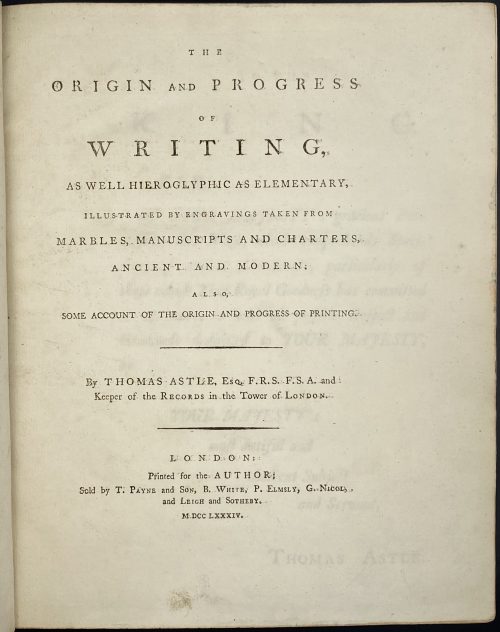 Full Title: THE | ORIGIN AND PROGRESS | OF | WRITING, | AS WELL HIEROGLYPHIC AS ELEMENTARY, | ILLUSTRATED BY ENGRAVINGS TAKEN FROM | MARBLES, MANUSCRIPTS AND CHARTERS, | ANCIENT AND MODERN. | ALSO, | SOME ACCOUNT OF THE ORIGIN AND PROGRESS OF PRINTING. | – | By THOMAS ASTLE, Esq. F.R.S. F.S.A. and | Keeper of the RECORDS in the Tower of LONDON. | – | LONDON: | Printed for the AUTHOR; | Sold by T. PAYNE and SON, B. White, P. Elmsly, G. Nicol, | and LEIGH and SOTHEBY. | M DCC LXXXIV. Pagination: ffl [i, ii] - t.p., blank, [iii, iv] - dedication, blank, [v] vi, vii - contents, [viii] - blank; [i] -xxv - introduction, [xxvi] blank; 1 - of the origin and progress... - 235 [236] blank (229-235 additions and corrections); on p. 235 imprint: FROM THE PRESS OF J. NICHOLS, MDCCLXXXIV; bfl; 31 plates: op. p. 64 (folding), 66, 70, 72 (2), 76, 80 (2, on recto and verso), 82 (2, on recto and verso), 84, 92, 94, 96 (folding), 98 (folding), 100, 102, 104 (folding), 106 (folding), 108 (folding), 112 (folding), 128 (folding), 140 (2, on recto and verso), 142, 146, 150 (folding), 158, 160, 176, 178, folding platessigned "B. T. Pouncy". Collation: [A4] a–c4 π1 B-Z4 Aa-Ff4 Gg2 Hh4. Size: 4to, 29.1 x 24.3 cm. Binding: contemporary full polished brown calf professionally re-backed, single-fillet gilt border to covers, raised bands, black title label with gilt lettering and gilt fillets, gilt year lettering to bottom. Printed on laid paper, margins marbled. Bookplates: "Alex-r Carlile" to front pastedown, "Nicholas Wall. Sometime his book" to back pastedown. To front pastedown: pencil inscriptions and pasted clipping about the book.
Full Title: THE | ORIGIN AND PROGRESS | OF | WRITING, | AS WELL HIEROGLYPHIC AS ELEMENTARY, | ILLUSTRATED BY ENGRAVINGS TAKEN FROM | MARBLES, MANUSCRIPTS AND CHARTERS, | ANCIENT AND MODERN. | ALSO, | SOME ACCOUNT OF THE ORIGIN AND PROGRESS OF PRINTING. | – | By THOMAS ASTLE, Esq. F.R.S. F.S.A. and | Keeper of the RECORDS in the Tower of LONDON. | – | LONDON: | Printed for the AUTHOR; | Sold by T. PAYNE and SON, B. White, P. Elmsly, G. Nicol, | and LEIGH and SOTHEBY. | M DCC LXXXIV. Pagination: ffl [i, ii] - t.p., blank, [iii, iv] - dedication, blank, [v] vi, vii - contents, [viii] - blank; [i] -xxv - introduction, [xxvi] blank; 1 - of the origin and progress... - 235 [236] blank (229-235 additions and corrections); on p. 235 imprint: FROM THE PRESS OF J. NICHOLS, MDCCLXXXIV; bfl; 31 plates: op. p. 64 (folding), 66, 70, 72 (2), 76, 80 (2, on recto and verso), 82 (2, on recto and verso), 84, 92, 94, 96 (folding), 98 (folding), 100, 102, 104 (folding), 106 (folding), 108 (folding), 112 (folding), 128 (folding), 140 (2, on recto and verso), 142, 146, 150 (folding), 158, 160, 176, 178, folding platessigned "B. T. Pouncy". Collation: [A4] a–c4 π1 B-Z4 Aa-Ff4 Gg2 Hh4. Size: 4to, 29.1 x 24.3 cm. Binding: contemporary full polished brown calf professionally re-backed, single-fillet gilt border to covers, raised bands, black title label with gilt lettering and gilt fillets, gilt year lettering to bottom. Printed on laid paper, margins marbled. Bookplates: "Alex-r Carlile" to front pastedown, "Nicholas Wall. Sometime his book" to back pastedown. To front pastedown: pencil inscriptions and pasted clipping about the book. -
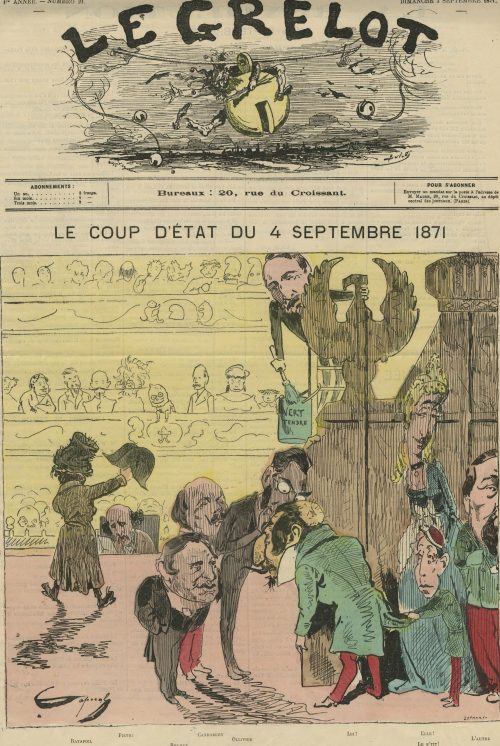 Le Grelot / journal illustré politique et satirique, №21, dimanche, 3 septembre 1871. Artist: Caporal (signed in the lower-left corner) Engraver/Printer: J. Lefman (signed LEFMAN SC in the lower-right corner) Title: LE COUP D'ÉTAT DU 4 SEPTEMBRE 1871. The Coup d'Etat of September 4th 1871. The artist equalled the 4th of September revolution when Napoleon III was ousted and the Second Empire collapsed, to a coup d'Etat. Although the number is marked September 3, it is dedicated to the events of September 4th. This was a usual French newspaper practice to postdate their issues. That's why they almost always operated with categories such as "today", "yesterday", and "tomorrow" instead of definitive calendar dates. "Le Grelot" means "The Sleigh Bell". Personages: Ratapoil – fictional personage invented by Honoré Daumier (French, 1808 – 1879), a Napoleon III caricaturized figure. Ratapoil is addressing the audience holding up Napoléon Bonaparte's tricorn cocked hat. Pietri – Joseph Marie Piétri [Joachim Piétri] (French, – is sitting in the first row, taking notes. Rouher – Eugène Rouher (French, 1814 – 1884), president of the Senat. Canrobert – François Marcellin Certain de Canrobert (French, 1809 – 1895), French Marshal, captured by the Prussian army in Metz with Marshal Bazaine during the surrender of Metz on October 28, 1870. Ollivier – Olivier Émile Ollivier (French, 1825 – 1913), head of the government. Hiding behind the theater decoration are: Napoleon III (Lui!), his wife Eugénie (Elle!), their son Prince Imperial (Le P'tit!), and Pierre Bonaparte (L'Autre). Sitting in the theatre box facing the scene: Adolphe Thiers (French, 1797 – 1877), Jules Favre (French, 1809 – 1880), Louis-Jules Trochu [Le General Trochu] (French, 1815 – 1896), and the other members of the "Government of National Defence". On the gallery: youngsters and two men in sans-culottes hats. An unidentified person on a ladder holding to an eagle figure is having a paintbrush and a bucket with 'tender green' paint. Ref: Musée Carnavalet
Le Grelot / journal illustré politique et satirique, №21, dimanche, 3 septembre 1871. Artist: Caporal (signed in the lower-left corner) Engraver/Printer: J. Lefman (signed LEFMAN SC in the lower-right corner) Title: LE COUP D'ÉTAT DU 4 SEPTEMBRE 1871. The Coup d'Etat of September 4th 1871. The artist equalled the 4th of September revolution when Napoleon III was ousted and the Second Empire collapsed, to a coup d'Etat. Although the number is marked September 3, it is dedicated to the events of September 4th. This was a usual French newspaper practice to postdate their issues. That's why they almost always operated with categories such as "today", "yesterday", and "tomorrow" instead of definitive calendar dates. "Le Grelot" means "The Sleigh Bell". Personages: Ratapoil – fictional personage invented by Honoré Daumier (French, 1808 – 1879), a Napoleon III caricaturized figure. Ratapoil is addressing the audience holding up Napoléon Bonaparte's tricorn cocked hat. Pietri – Joseph Marie Piétri [Joachim Piétri] (French, – is sitting in the first row, taking notes. Rouher – Eugène Rouher (French, 1814 – 1884), president of the Senat. Canrobert – François Marcellin Certain de Canrobert (French, 1809 – 1895), French Marshal, captured by the Prussian army in Metz with Marshal Bazaine during the surrender of Metz on October 28, 1870. Ollivier – Olivier Émile Ollivier (French, 1825 – 1913), head of the government. Hiding behind the theater decoration are: Napoleon III (Lui!), his wife Eugénie (Elle!), their son Prince Imperial (Le P'tit!), and Pierre Bonaparte (L'Autre). Sitting in the theatre box facing the scene: Adolphe Thiers (French, 1797 – 1877), Jules Favre (French, 1809 – 1880), Louis-Jules Trochu [Le General Trochu] (French, 1815 – 1896), and the other members of the "Government of National Defence". On the gallery: youngsters and two men in sans-culottes hats. An unidentified person on a ladder holding to an eagle figure is having a paintbrush and a bucket with 'tender green' paint. Ref: Musée Carnavalet -
![George Cruikshank's table-book / edited by Gilbert Abbott à Beckett. – London: Punch office, 1845. – viii, 284 p., [12] leaves of plates : ill's.](https://varshavskycollection.com/wp-content/uploads/2021/02/LIB-2557.2020-5-500x722.jpeg) Title: GEORGE CRUIKSHANK'S | TABLE-BOOK. | EDITED BY | GILBERT ABBOTT À BECKETT. | ILLUSTRATED BY GEORGE CRUIKSHANK. | LONDON : | PUBLISHED AT THE PUNCH OFFICE, 92, FLEET STREET ; | AND SOLD BY ALL BOOKSELLERS. | MDCCCXLV.|| Pagination: ffl [2 blanks] [i, ii - engaved t.p. w/guard, verso blank] [iii], iv - letterpress t.p., colophon] [v], vi - list of engravings on still and on wood, [vii] viii - contents [2 - blank, engraved frontispiece] [1] 2-284 [2 blanks] bfl; 12 full-page steel etchings and 116 woodcuts and glyphographs by G. Cruikshank. Binding: Hardcover, 4to, 24.4 x 17 cm, later full red morocco by Kelly and Sons with gilt and embossed designs to covers, designs, title and year lettering to spine, facsimile in gilt of Cruikshank's signature to front cover, gilt line to inner edges, top edge gilt, marbled endpapers. Armorial bookplate of Harold A. Wernher of Luton Hoo to front pastedown. Major-General Sir Harold Augustus Wernher (1893 – 1973) – British military officer. Originally bound in red cloth, this binding by Kelly and Sons (Packer, Maurice. Bookbinders of Victorian London. — London: British Library, 1991 page 84). Title without the bottom section with lettering, on top lacking the 'Price one shilling', № 1, Vol. 1. inscriptions. Catalogue raisonné: A. M. Cohn № 191, p. 66-67.
Title: GEORGE CRUIKSHANK'S | TABLE-BOOK. | EDITED BY | GILBERT ABBOTT À BECKETT. | ILLUSTRATED BY GEORGE CRUIKSHANK. | LONDON : | PUBLISHED AT THE PUNCH OFFICE, 92, FLEET STREET ; | AND SOLD BY ALL BOOKSELLERS. | MDCCCXLV.|| Pagination: ffl [2 blanks] [i, ii - engaved t.p. w/guard, verso blank] [iii], iv - letterpress t.p., colophon] [v], vi - list of engravings on still and on wood, [vii] viii - contents [2 - blank, engraved frontispiece] [1] 2-284 [2 blanks] bfl; 12 full-page steel etchings and 116 woodcuts and glyphographs by G. Cruikshank. Binding: Hardcover, 4to, 24.4 x 17 cm, later full red morocco by Kelly and Sons with gilt and embossed designs to covers, designs, title and year lettering to spine, facsimile in gilt of Cruikshank's signature to front cover, gilt line to inner edges, top edge gilt, marbled endpapers. Armorial bookplate of Harold A. Wernher of Luton Hoo to front pastedown. Major-General Sir Harold Augustus Wernher (1893 – 1973) – British military officer. Originally bound in red cloth, this binding by Kelly and Sons (Packer, Maurice. Bookbinders of Victorian London. — London: British Library, 1991 page 84). Title without the bottom section with lettering, on top lacking the 'Price one shilling', № 1, Vol. 1. inscriptions. Catalogue raisonné: A. M. Cohn № 191, p. 66-67. -
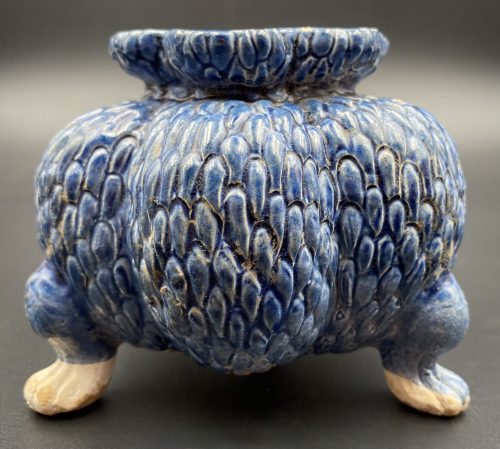 Small six-lobed tripod censer with an outer surface decorated in a form of dragon skin, distant parts of the feet and centre of the bottom unglazed, a drip of blue glaze inside. China, the Tang dynasty [唐朝] (618 – 907). Diameter: 8 cm; Height: 7 cm.
Small six-lobed tripod censer with an outer surface decorated in a form of dragon skin, distant parts of the feet and centre of the bottom unglazed, a drip of blue glaze inside. China, the Tang dynasty [唐朝] (618 – 907). Diameter: 8 cm; Height: 7 cm. -
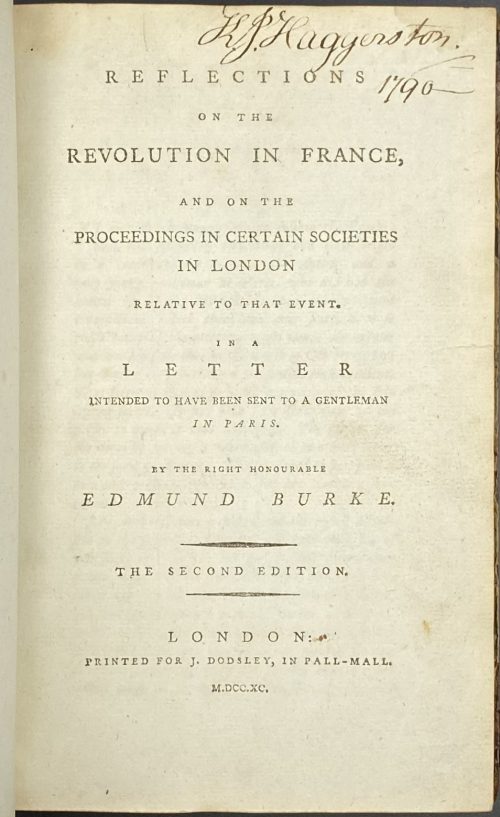 Title: REFLECTIONS | ON THE | REVOLUTION IN FRANCE, | AND ON THE | PROCEEDINGS IN CERTAIN SOCIETIES | IN LONDON | RELATIVE TO THAT EVENT. | IN A | LETTER | INTENDED TO HAVE BEEN SENT TO A GENTLEMAN | IN PARIS. | BY THE RIGHT HONOURABLE | EDMUND BURKE. | — | {in lozenges} THE SECOND EDITION. | —| LONDON: | PRINTED FOR J. DODSLEY, IN PALL-MALL. | M.DCC.XC. || Pagination: [4 blanks] [i-iii] iv, 1-356 [4 blanks]. Collation: 8vo; π2 B-Z8, Aa2. Binding: Quarter calf with marbled boards, gilt fillets, red label with gilt lettering to spine. "King John Haggerston, 1790" handwritten ink inscription to front endpaper, t.p. and p. iii. Seems like Sir John Haggerston, 9th Baronet.
Title: REFLECTIONS | ON THE | REVOLUTION IN FRANCE, | AND ON THE | PROCEEDINGS IN CERTAIN SOCIETIES | IN LONDON | RELATIVE TO THAT EVENT. | IN A | LETTER | INTENDED TO HAVE BEEN SENT TO A GENTLEMAN | IN PARIS. | BY THE RIGHT HONOURABLE | EDMUND BURKE. | — | {in lozenges} THE SECOND EDITION. | —| LONDON: | PRINTED FOR J. DODSLEY, IN PALL-MALL. | M.DCC.XC. || Pagination: [4 blanks] [i-iii] iv, 1-356 [4 blanks]. Collation: 8vo; π2 B-Z8, Aa2. Binding: Quarter calf with marbled boards, gilt fillets, red label with gilt lettering to spine. "King John Haggerston, 1790" handwritten ink inscription to front endpaper, t.p. and p. iii. Seems like Sir John Haggerston, 9th Baronet. -
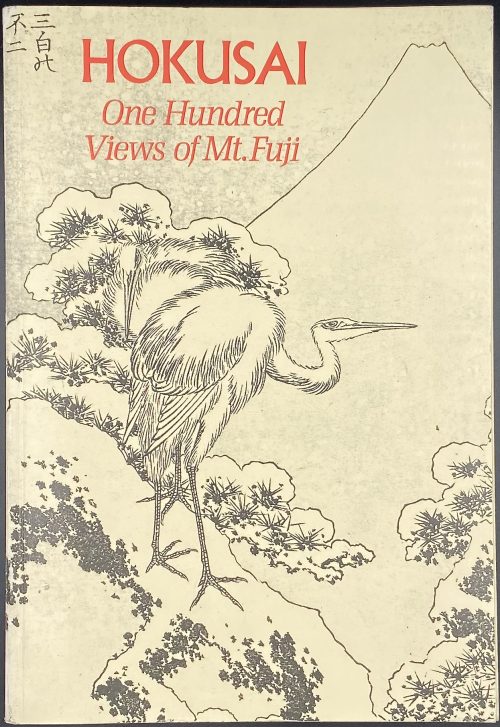 Softcover, 24 x 16.5 cm, publisher's pictorial wrappers, lettering to spine, pp.: [6] 7-224. Full reproduction of Katsushika Hokusai's [葛飾 北斎] (Japanese, 1760 – 1849) series of three illustrated books [絵本, e-hon] One Hundred Views of Mount Fuji [富嶽百景, Fugaku hyakkei], published in Japan in 1834-1849, with commentaries.
Softcover, 24 x 16.5 cm, publisher's pictorial wrappers, lettering to spine, pp.: [6] 7-224. Full reproduction of Katsushika Hokusai's [葛飾 北斎] (Japanese, 1760 – 1849) series of three illustrated books [絵本, e-hon] One Hundred Views of Mount Fuji [富嶽百景, Fugaku hyakkei], published in Japan in 1834-1849, with commentaries. -
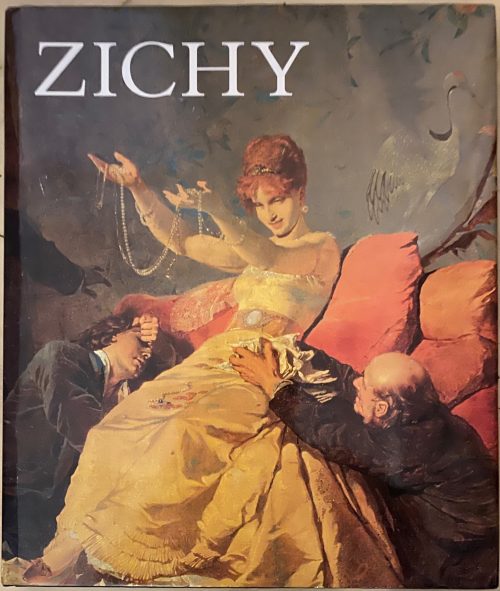 Title: ZICHI | A bevezető tanulmányt írta | és a képeket válogatta | GELLÉR KATALIN | Introduced and selected by | KATALIN GELLÉR | CORVINA || Pagination: [1-4] 5-44 + 34 leaves of illustrations, (66 plates). Exterior: 32.5 x 28 cm, hardcover, original dark green cloth with silver lettering to spine, pictorial DJ. Text in Hungarian and English. Artist: Mihály Zichy [Michael von Zichy] (Hungarian, 1827 – 1906).
Title: ZICHI | A bevezető tanulmányt írta | és a képeket válogatta | GELLÉR KATALIN | Introduced and selected by | KATALIN GELLÉR | CORVINA || Pagination: [1-4] 5-44 + 34 leaves of illustrations, (66 plates). Exterior: 32.5 x 28 cm, hardcover, original dark green cloth with silver lettering to spine, pictorial DJ. Text in Hungarian and English. Artist: Mihály Zichy [Michael von Zichy] (Hungarian, 1827 – 1906). -
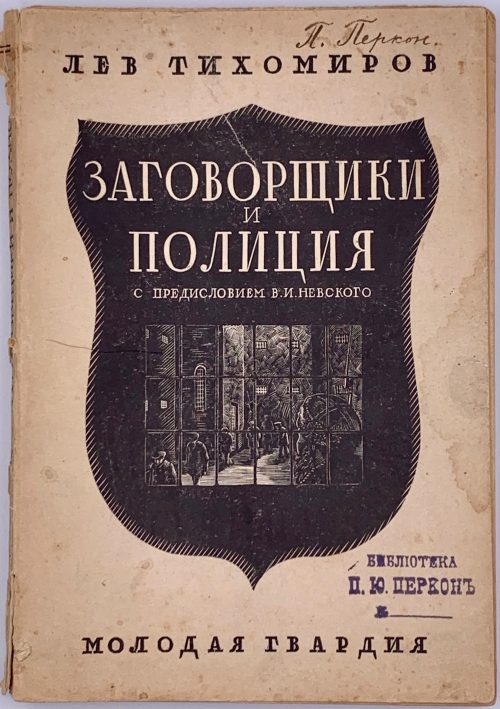 Front pictorial wrapper: ЛЕВ ТИХОМИРОВ | ЗАГОВОРЩИКИ | И | ПОЛИЦИЯ | С ПРЕДИСЛОВИЕМ В. И. НЕВСКОГО | МОЛОДАЯ ГВАРДИЯ || Title page: РЕВОЛЮЦИОННОЕ ДВИЖЕНИЕ В РОССИИ В МЕМУАРАХ | СОВРЕМЕННИКОВ | ПОД РЕДАКЦИЕЙ В. НЕВСКОГО И П. АНАТОЛЬЕВА | ЛЕВ ТИХОМИРОВ | ЗАГОВОРЩИКИ | И | ПОЛИЦИЯ | ПРЕДИСЛОВИЕ В. НЕВСКОГО | МОЛОДАЯ ГВАРДИЯ | МОСКВА – ЛЕНИНГРАД || Title verso: Обложка – гравюра на дереве | работы Н. П. Дмитровского | {printer’s device} | Издат. № 2633 | Ленинградский Областлит № 8371 | Тираж 5.000 экз. | 1928 г. Back wrapper: Заказы направлять: | [….] | {publisher’s device} | 1 р. 25 коп. | Р || Pagination: [1-3] 4-229 [3]; pp. 205-226 – notes, 227-229 – index. Collation: [1]8 2-148 154. Binding: publisher’s pictorial wrappers, lettering to spine and back cover. Print run 5,000 copies. Provenance: П. Ю. Перкон (to front cover nut-ink inscription: «П. Перкон», blue ink stamp to cover and t.p.: «БИБЛИОТЕКА | П. Ю. ПЕРКОНЪ | №» Personae: Перкон, Петр Юрьевич [Густавович] (Latvian, 1885 – 1938) — member of the communist party (Bolsheviks) since 05.1905; arrested: 05.02.1938, shot: 22.04.1938. — Previous owner. Невский, Владимир Иванович [Кривобоков or Кривобок, Феодосий Иванович] (Russian, 1876 – 1937) — arrested: 20.02.1935, shot: 26.05.1937. — Editor of the series and author of the foreword. Анатольев, П. И. [Фаресов, Анатолий Иванович; Faresov, Anatoly (Russian, 1852 – 1928). — Editor of the series. Тихомиров, Лев Александрович (Russian, 1852 – 1923). — Author of the text. Дмитревский [Дмитриевский; Дмитровский], Николай Павлович (Russian, 1890 — 1938) — arrested 15.12.1937 , shot: 02.01.1938. — Artist/engraver of the woodcut on the cover.
Front pictorial wrapper: ЛЕВ ТИХОМИРОВ | ЗАГОВОРЩИКИ | И | ПОЛИЦИЯ | С ПРЕДИСЛОВИЕМ В. И. НЕВСКОГО | МОЛОДАЯ ГВАРДИЯ || Title page: РЕВОЛЮЦИОННОЕ ДВИЖЕНИЕ В РОССИИ В МЕМУАРАХ | СОВРЕМЕННИКОВ | ПОД РЕДАКЦИЕЙ В. НЕВСКОГО И П. АНАТОЛЬЕВА | ЛЕВ ТИХОМИРОВ | ЗАГОВОРЩИКИ | И | ПОЛИЦИЯ | ПРЕДИСЛОВИЕ В. НЕВСКОГО | МОЛОДАЯ ГВАРДИЯ | МОСКВА – ЛЕНИНГРАД || Title verso: Обложка – гравюра на дереве | работы Н. П. Дмитровского | {printer’s device} | Издат. № 2633 | Ленинградский Областлит № 8371 | Тираж 5.000 экз. | 1928 г. Back wrapper: Заказы направлять: | [….] | {publisher’s device} | 1 р. 25 коп. | Р || Pagination: [1-3] 4-229 [3]; pp. 205-226 – notes, 227-229 – index. Collation: [1]8 2-148 154. Binding: publisher’s pictorial wrappers, lettering to spine and back cover. Print run 5,000 copies. Provenance: П. Ю. Перкон (to front cover nut-ink inscription: «П. Перкон», blue ink stamp to cover and t.p.: «БИБЛИОТЕКА | П. Ю. ПЕРКОНЪ | №» Personae: Перкон, Петр Юрьевич [Густавович] (Latvian, 1885 – 1938) — member of the communist party (Bolsheviks) since 05.1905; arrested: 05.02.1938, shot: 22.04.1938. — Previous owner. Невский, Владимир Иванович [Кривобоков or Кривобок, Феодосий Иванович] (Russian, 1876 – 1937) — arrested: 20.02.1935, shot: 26.05.1937. — Editor of the series and author of the foreword. Анатольев, П. И. [Фаресов, Анатолий Иванович; Faresov, Anatoly (Russian, 1852 – 1928). — Editor of the series. Тихомиров, Лев Александрович (Russian, 1852 – 1923). — Author of the text. Дмитревский [Дмитриевский; Дмитровский], Николай Павлович (Russian, 1890 — 1938) — arrested 15.12.1937 , shot: 02.01.1938. — Artist/engraver of the woodcut on the cover. -
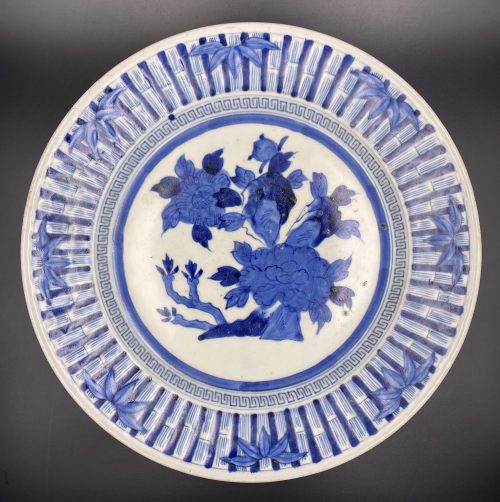 Underglaze cobalt blue and white porcelain plate decorated with a bamboo border, key fret above the blue ring, and a bush of chrysanthemums in the centre. The bottom is decorated with stylized clouds and flowers, a border of lotus petals and signed with a general mark in the centre. Diameter: 29.5 cm; Height: 3.5 cm.
Underglaze cobalt blue and white porcelain plate decorated with a bamboo border, key fret above the blue ring, and a bush of chrysanthemums in the centre. The bottom is decorated with stylized clouds and flowers, a border of lotus petals and signed with a general mark in the centre. Diameter: 29.5 cm; Height: 3.5 cm. -
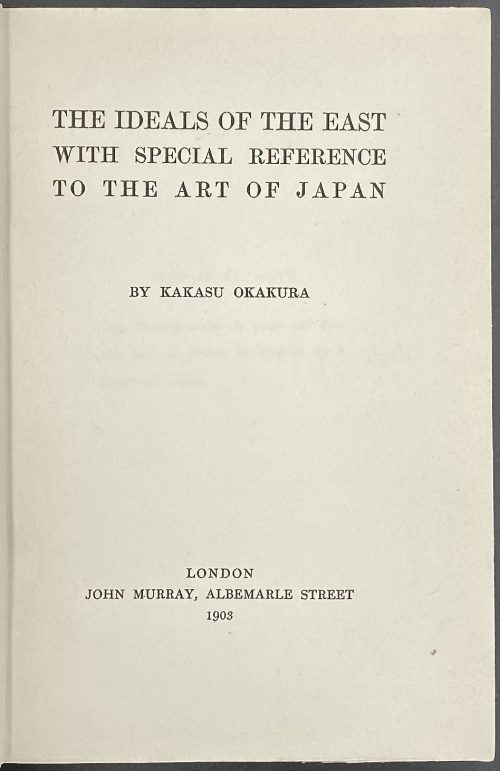 Title: THE IDEALS OF THE EAST | WITH SPECIAL REFERENCE | TO THE ART OF JAPAN | BY KAKASU OKAKURA | LONDON | JOHN MURRAY, ALBEMARLE STREET | 1903 || Collation: 8vo; ffl, [2] (t.p., prep. note) [a]4 b4, A-P8 Q4. Pagination: ffl, [I, ii] – h.t. / blank, [iii, iv] – t.p. / blank, [v, vi] – preparatory note / blank, vii-xxii, [1] 2-244, [1] 2-4 (Works for art lovers). Binding: Burgundy cloth, red flowers and lettering to cover, gilt lettering to spine. Size: 19.5 x 13 cm Contributors: Author: Okakura Kakuzō [岡倉 覚三] (1863 – 1913). Publisher: Murray, Sir John IV (1851–1928); John Murray (publishing house). Printer: Ballantyne, Hanson & Co., Edinburgh, London.
Title: THE IDEALS OF THE EAST | WITH SPECIAL REFERENCE | TO THE ART OF JAPAN | BY KAKASU OKAKURA | LONDON | JOHN MURRAY, ALBEMARLE STREET | 1903 || Collation: 8vo; ffl, [2] (t.p., prep. note) [a]4 b4, A-P8 Q4. Pagination: ffl, [I, ii] – h.t. / blank, [iii, iv] – t.p. / blank, [v, vi] – preparatory note / blank, vii-xxii, [1] 2-244, [1] 2-4 (Works for art lovers). Binding: Burgundy cloth, red flowers and lettering to cover, gilt lettering to spine. Size: 19.5 x 13 cm Contributors: Author: Okakura Kakuzō [岡倉 覚三] (1863 – 1913). Publisher: Murray, Sir John IV (1851–1928); John Murray (publishing house). Printer: Ballantyne, Hanson & Co., Edinburgh, London. -
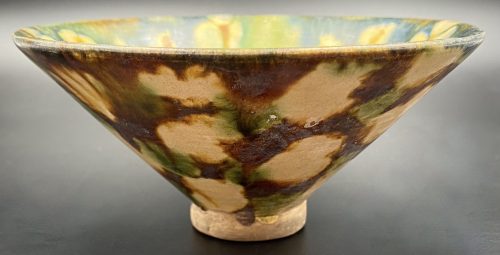 Footed conical bowl decorated with cream and brown splashes on green background inside, and cream and green splashes on the brown background outside. Diameter: 13.5 cm, H: 6.2 cm;
Footed conical bowl decorated with cream and brown splashes on green background inside, and cream and green splashes on the brown background outside. Diameter: 13.5 cm, H: 6.2 cm; -

The thin iron plate of round form and black colour carved in sukidashi-bori with the design of rocks, waves, bridge, mountain pavilion and 5-storey pagoda under the moon, on both sides, alluding to Todai-ji temple in Nara. Slightly rounded rectangular hitsu-ana probably pierced later. Very narrow raised rim as usual in katsushi tsuba. In a modern wooden box.
Late Muromachi period, 16th century. Dimensions: 81.1 x 79.5 x 3. mm (seppa-dai), 2.2 mm (base plate), 4.4. (rim).Reference: “Art of the Samurai” on page 232, №140: ”Kamakura tsuba with Sangatsu-do tower and bridge. Muromachi period, 16th century. 83 mm x 80 mm. Unsigned. Tokyo National Museum. The mountain pavilion and bridge carved in sunken relief on the iron tsuba – both part of Tōdai-ji, a temple in Nara – are detailed in fine kebori (line) engraving. As a result of the chiselling used to create the relief, the ground of the piece is relatively thin”. Also page 41 in Tsuba Kanshoki. Kazutaro Torogoye, 1975 [LIB-1480.2018].
This tsuba is very much similar to TSU-0384. -
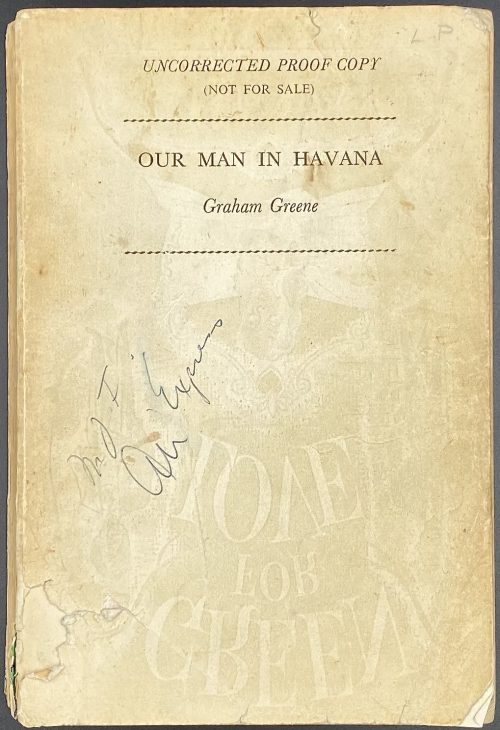 Front cover: UNCORRECTED PROOF COPY | (NOT FOR SALE) | {rule} | OUR MAN IN HAVANA | Graham Greene | {rule} || Half-title: Our Man in Havana ||; stamp on top: LAURENCE POLLINGER LTD. | 18 MADDOX STREET, LONDON, W.1. Title page: {double rule} | Our Man in Havana | AN ENTERTAINMENT | GRAHAM GREENE | {Heinemann’s device} | HEINEMANN | LONDON MELBOURNE TORONTO || Title verso: William Heinemann Ltd | LONDON MELBOURNE TORONTO | CAPE TOWN AUCKLAND | THE HAGUE | First published 1958 | © by Graham Greene 1958 | All rights reserved | Printed in Great Britain | at The Windmill Press | Kingswood, Surrey || Pagination: [6] [1, 2] 3-273 [274]. Binding: 19.5 x 13 cm, cream wrappers with black lettering to front and spine; Cover is verso of the cover for Anne Piper’s Green for Love, a book published by Fletcher & Son in 1954. Edition: Advance copy / Uncorrected proof. Contributors: Henry Graham Greene (British, 1904 – 1991) – author. William Henry Heinemann (British-Jewish, 1863 – 1920); William Heinemann Limited – publisher. Laurence Pollinger Ltd. (London) – literary agent.
Front cover: UNCORRECTED PROOF COPY | (NOT FOR SALE) | {rule} | OUR MAN IN HAVANA | Graham Greene | {rule} || Half-title: Our Man in Havana ||; stamp on top: LAURENCE POLLINGER LTD. | 18 MADDOX STREET, LONDON, W.1. Title page: {double rule} | Our Man in Havana | AN ENTERTAINMENT | GRAHAM GREENE | {Heinemann’s device} | HEINEMANN | LONDON MELBOURNE TORONTO || Title verso: William Heinemann Ltd | LONDON MELBOURNE TORONTO | CAPE TOWN AUCKLAND | THE HAGUE | First published 1958 | © by Graham Greene 1958 | All rights reserved | Printed in Great Britain | at The Windmill Press | Kingswood, Surrey || Pagination: [6] [1, 2] 3-273 [274]. Binding: 19.5 x 13 cm, cream wrappers with black lettering to front and spine; Cover is verso of the cover for Anne Piper’s Green for Love, a book published by Fletcher & Son in 1954. Edition: Advance copy / Uncorrected proof. Contributors: Henry Graham Greene (British, 1904 – 1991) – author. William Henry Heinemann (British-Jewish, 1863 – 1920); William Heinemann Limited – publisher. Laurence Pollinger Ltd. (London) – literary agent. -
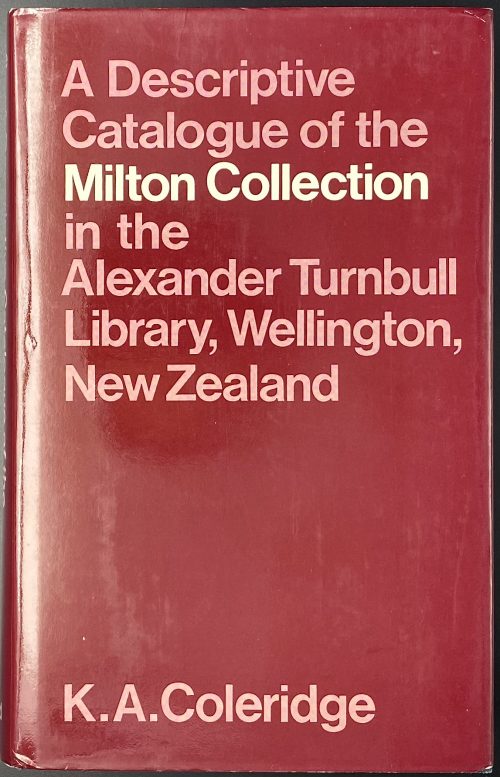 Title page: A DESCRIPTIVE CATALOGUE | OF THE | MILTON COLLECTION | IN THE ALEXANDER | TURNBULL LIBRARY, | WELLINGTON, | NEW ZEALAND |Describing works printed before 1801 | held in the Library at December 1975 | COMPILED BY | K. A. COLERIDGE | Published for the Alexander Turnbull Library, | National Library of New Zealand, | by OXFORD UNIVERSITY PRESS | 1980. Pagination: [i-v] vi-xxv [xxvi blank], [1] 2-536, plus 27 leaves with 60 plates. Printer: Printed in Great Britain at the Pitman Press, Bath. Size: 22.5 x 14.5 cm. Binding: Black cloth, gilt lettering to spine, lettered maroon dust-jacket, unclipped (£35.00 net in UK). Contributor: Kathleen A. Coleridge (New Zealand, b. 1944).
Title page: A DESCRIPTIVE CATALOGUE | OF THE | MILTON COLLECTION | IN THE ALEXANDER | TURNBULL LIBRARY, | WELLINGTON, | NEW ZEALAND |Describing works printed before 1801 | held in the Library at December 1975 | COMPILED BY | K. A. COLERIDGE | Published for the Alexander Turnbull Library, | National Library of New Zealand, | by OXFORD UNIVERSITY PRESS | 1980. Pagination: [i-v] vi-xxv [xxvi blank], [1] 2-536, plus 27 leaves with 60 plates. Printer: Printed in Great Britain at the Pitman Press, Bath. Size: 22.5 x 14.5 cm. Binding: Black cloth, gilt lettering to spine, lettered maroon dust-jacket, unclipped (£35.00 net in UK). Contributor: Kathleen A. Coleridge (New Zealand, b. 1944). -
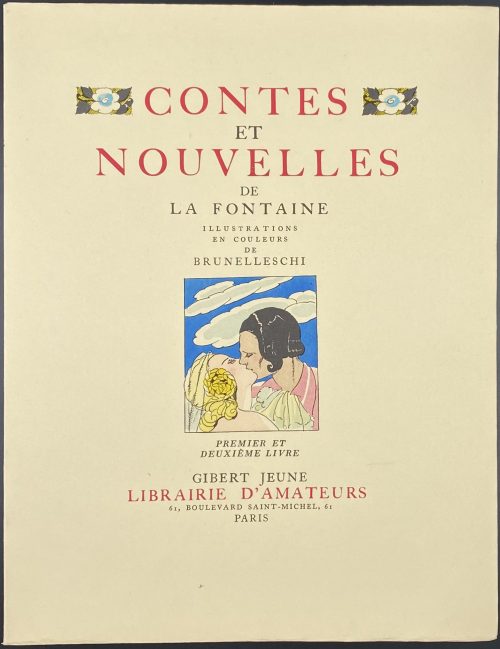 Vol. 1: Front wrapper and title page (in red and black): CONTES | ET | NOUVELLES | DE | LA FONTAINE | ILLUSTRATIONS | EN COULEURS | DE | BRUNELLESCHI | {vignette} | PREMIER ET DEUXIÈME LIVRE | GIBERT JEUNE | LIBRAIRIE D'AMATEURS | 61, BOULEVARD SAINT-MICHEL, 61 | PARIS || Pagination: [2] – blanks, [2] – h.t. / limit., [2] – t.p. / blank, [6] – advert., [2] – d.t.p., 1-164 [165-6], [4] – table, [2] – imprint / blank, [2] – blanks; total 188 pages (94 leaves) with 35 in-text black illustrations, plus 16 colour plates extraneous to collation, incl. frontispiece. Vol. 2: Front wrapper and title page similar to Vol. 1 but TROISIÈME, QUATRIÈME ET CINQUIÈME LIVRE under the vignette. Pagination: [2] – blanks, [2] – h.t. / limit., [2] – t.p. / blank, [2] – d.t.p., 1-233 [234], [4] – table, [2] – colophon / blank, [2] – blanks; total 250 pages (125 leaves) with 42 in-text black illustrations, plus 16 colour plates extraneous to collation, incl. frontispiece. Edition: Limited edition of 3,000 copies, this copy is № 1 (stamped in black in vol. 1). Printed on the 10th of June, 1938 by J. Dumoulin (H. Barthélemy – director, Louis Malexis – mise en page); stencil-colouring (au pochoir) by E. Charpentier under direction of the artist. Binding: Two volumes 26.3 x 20.3 cm, uniformly bound in publisher’s pictorial flapped wrappers with vignettes and lettering to front wrapper and spine and publisher’s device to back wrapper. Description of the stensil (au pochoir) technique.
Vol. 1: Front wrapper and title page (in red and black): CONTES | ET | NOUVELLES | DE | LA FONTAINE | ILLUSTRATIONS | EN COULEURS | DE | BRUNELLESCHI | {vignette} | PREMIER ET DEUXIÈME LIVRE | GIBERT JEUNE | LIBRAIRIE D'AMATEURS | 61, BOULEVARD SAINT-MICHEL, 61 | PARIS || Pagination: [2] – blanks, [2] – h.t. / limit., [2] – t.p. / blank, [6] – advert., [2] – d.t.p., 1-164 [165-6], [4] – table, [2] – imprint / blank, [2] – blanks; total 188 pages (94 leaves) with 35 in-text black illustrations, plus 16 colour plates extraneous to collation, incl. frontispiece. Vol. 2: Front wrapper and title page similar to Vol. 1 but TROISIÈME, QUATRIÈME ET CINQUIÈME LIVRE under the vignette. Pagination: [2] – blanks, [2] – h.t. / limit., [2] – t.p. / blank, [2] – d.t.p., 1-233 [234], [4] – table, [2] – colophon / blank, [2] – blanks; total 250 pages (125 leaves) with 42 in-text black illustrations, plus 16 colour plates extraneous to collation, incl. frontispiece. Edition: Limited edition of 3,000 copies, this copy is № 1 (stamped in black in vol. 1). Printed on the 10th of June, 1938 by J. Dumoulin (H. Barthélemy – director, Louis Malexis – mise en page); stencil-colouring (au pochoir) by E. Charpentier under direction of the artist. Binding: Two volumes 26.3 x 20.3 cm, uniformly bound in publisher’s pictorial flapped wrappers with vignettes and lettering to front wrapper and spine and publisher’s device to back wrapper. Description of the stensil (au pochoir) technique. -
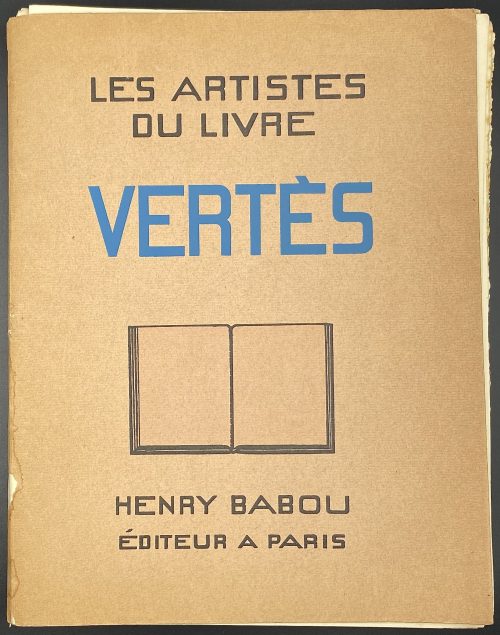 Title-page: LES ARTISTES DU LIVRE | MARCEL | VERTÈS | ÉTUDE PAR | ANDRÉ SALMON | LETTRE-PRÉFACE PAR | PAUL MORAND | PORTRAIT PAR | JEAN OBERLÉ | { publisher’s device} | HENRY BABOU, ÉDITEUR | 1, RUE VERNIQUET, PARIS | 1930 || Description: 26.3 x 20.5 cm, French flapped brown wrappers with black and blue lettering, lettering to spine, unbound, [1-2] 1st blank leaf, [3-4] h.t. / limitation, two plates (fac-simile letter and portrait of Vertès), [5-6] t.p. /”Cette monographie…”, 7-39 [40-48], incl. Bibliographie des ouvrages, Table des planches, and colophon – all with in-text illustrations; plus 22 leaves of plates, one on a double-page, all with foxing and marginal browning. Printing: December 1930 by Durcos & Colas in Paris. Edition: the 17th edition in the series “Les artistes du livre’, published under the direction of Marcel Valotaire; print run limited to 700 copies of which 50 on Japon (numbered 1-50) enriched with one original unpublished drypoint, 650 copies on Vélin Blanc from Arches (50-650), and 50 “non-commercial” copies (I-L). This copy is numbered № 473. Contributors: Marcel Vertès [Marcell Vértes] (Jewish-Hungarian-French, 1895 – 1961) – artist. André Salmon (French, 1881 – 1969) – author. Paul Morand (French, 1888 – 1976) – author. Jean Oberlé (French, 1900 – 1961) – artist. Maitres-imprimeurs Ducros et Colas (Paris) – printer. Henry Babou (Paris) – publisher. Marcel Valotaire (French, 1889 – 1979) – publisher. Other names: Marcel Vertès, Marcel Vertes, Marcell Vértes
Title-page: LES ARTISTES DU LIVRE | MARCEL | VERTÈS | ÉTUDE PAR | ANDRÉ SALMON | LETTRE-PRÉFACE PAR | PAUL MORAND | PORTRAIT PAR | JEAN OBERLÉ | { publisher’s device} | HENRY BABOU, ÉDITEUR | 1, RUE VERNIQUET, PARIS | 1930 || Description: 26.3 x 20.5 cm, French flapped brown wrappers with black and blue lettering, lettering to spine, unbound, [1-2] 1st blank leaf, [3-4] h.t. / limitation, two plates (fac-simile letter and portrait of Vertès), [5-6] t.p. /”Cette monographie…”, 7-39 [40-48], incl. Bibliographie des ouvrages, Table des planches, and colophon – all with in-text illustrations; plus 22 leaves of plates, one on a double-page, all with foxing and marginal browning. Printing: December 1930 by Durcos & Colas in Paris. Edition: the 17th edition in the series “Les artistes du livre’, published under the direction of Marcel Valotaire; print run limited to 700 copies of which 50 on Japon (numbered 1-50) enriched with one original unpublished drypoint, 650 copies on Vélin Blanc from Arches (50-650), and 50 “non-commercial” copies (I-L). This copy is numbered № 473. Contributors: Marcel Vertès [Marcell Vértes] (Jewish-Hungarian-French, 1895 – 1961) – artist. André Salmon (French, 1881 – 1969) – author. Paul Morand (French, 1888 – 1976) – author. Jean Oberlé (French, 1900 – 1961) – artist. Maitres-imprimeurs Ducros et Colas (Paris) – printer. Henry Babou (Paris) – publisher. Marcel Valotaire (French, 1889 – 1979) – publisher. Other names: Marcel Vertès, Marcel Vertes, Marcell Vértes -
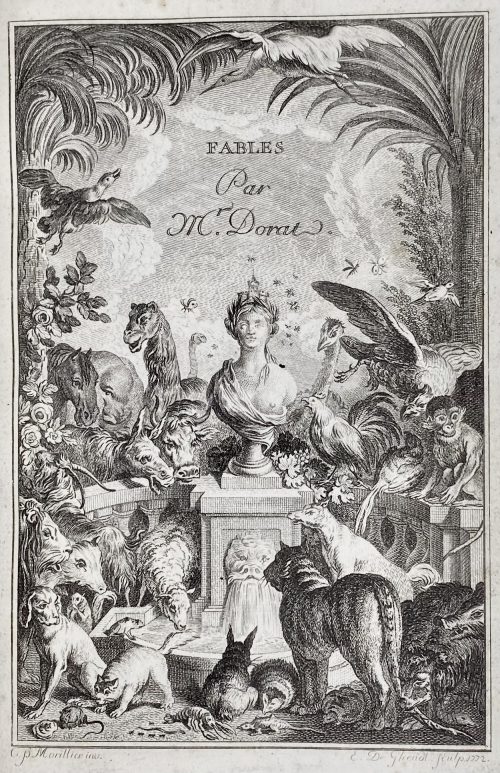 Title-page: FABLES | NOUVELLES. | {vignette by Ponce after Marillier} | A LA HAYE, | Et se trouve a Paris, | Chez Delalain, rue de la Comédie Françoise. | — | M. DCC. LXXIII. || Collation: 2 volumes (4 livres) in one, 1st blank, engraved t.p. “FABLES | Par | Mr. Dorat.” signed C. P. Marillier, inv. – E. D. Ghendt Sculp. 1772; a-c4, A-Z4 2A-2Q4, last blank, plus engraved frontispiece before A1 by Nicolas Delaunay and engraved d.t.p. before Z1: “Fables | de M. Dorat | II. Volume” also by Ghendt after Marillier., 99 vignettes and 99 tailpieces, all after Marillier. Lacking Delaunay frontispiece for the second volume (similar to the 1st). Edition: This is a vol. 1 176 pp. copy (Ray, 43). 2nd edition after Fables ou allégories philosophiques, 1772, p. 162 corrected: “Je sais , même au sein des poisons / Puiser le suc qui m'est utile”. Page xxii numbered correctly; on top of p. iii, printed a chain instead of a triple fillet in later issues (Ray, 43A). Pagination: [i, ii] iii-xxii, [2 d.t.p. «Livre premier»] [1] 2-309 [3 table], 3 plates. Binding: Crimson crashed morocco (198 x 133 mm) ruled in gilt, spine with raised bands gilt in compartments with gilt-lettered cream calf label, gilt dentelle inside, marbled endpapers, Pauli Menso bookplate pasted to front pastedown, printed on laid paper, AEG. Catalogue raisonné: Cohen-DeRicci: 313-315; Ray (French): № 43, pp. 81-83. Provenance: Pauli Menso. We only present a sample of illustrations, as their total number is enormous. Contributors: Author: Claude Joseph Dorat (French, 1734–1780) Publisher: Delalain (firm) (18th century) Artist: Clément Pierre Marillier (French, 1740–1808) Engravers: Jean Charles Baquoy (French, 1721–1777) Nicolas Delaunay (French, 1739–1792) Pierre Duflos (French, born in 1751) Emmanuel Jean Nepomucène de Ghendt (Flemish, worked in France, 1738–1815) Yves-Marie Le Gouaz (French, 1742–1816) Pierre Adrien Le Beau (French, 1748–after 1800) Jean-Jacques André Le Veau (French, 1729–1786) Charles Louis Lingée (French, 1748–1819) Joseph de Longueil (French, 1730–1792) Louis Legrand (French, 1723–1807) Jacques Le Roy (French, born in 1739) Louis Joseph Masquelier (French, 1741–1811) François Denis Née (French, 1735–1818) Nicholas Ponce (French, 1746–1831) Marguerite (Hémery) Ponce (French, born in 1745) Jean Baptiste Simonet (French, 1742–1813)
Title-page: FABLES | NOUVELLES. | {vignette by Ponce after Marillier} | A LA HAYE, | Et se trouve a Paris, | Chez Delalain, rue de la Comédie Françoise. | — | M. DCC. LXXIII. || Collation: 2 volumes (4 livres) in one, 1st blank, engraved t.p. “FABLES | Par | Mr. Dorat.” signed C. P. Marillier, inv. – E. D. Ghendt Sculp. 1772; a-c4, A-Z4 2A-2Q4, last blank, plus engraved frontispiece before A1 by Nicolas Delaunay and engraved d.t.p. before Z1: “Fables | de M. Dorat | II. Volume” also by Ghendt after Marillier., 99 vignettes and 99 tailpieces, all after Marillier. Lacking Delaunay frontispiece for the second volume (similar to the 1st). Edition: This is a vol. 1 176 pp. copy (Ray, 43). 2nd edition after Fables ou allégories philosophiques, 1772, p. 162 corrected: “Je sais , même au sein des poisons / Puiser le suc qui m'est utile”. Page xxii numbered correctly; on top of p. iii, printed a chain instead of a triple fillet in later issues (Ray, 43A). Pagination: [i, ii] iii-xxii, [2 d.t.p. «Livre premier»] [1] 2-309 [3 table], 3 plates. Binding: Crimson crashed morocco (198 x 133 mm) ruled in gilt, spine with raised bands gilt in compartments with gilt-lettered cream calf label, gilt dentelle inside, marbled endpapers, Pauli Menso bookplate pasted to front pastedown, printed on laid paper, AEG. Catalogue raisonné: Cohen-DeRicci: 313-315; Ray (French): № 43, pp. 81-83. Provenance: Pauli Menso. We only present a sample of illustrations, as their total number is enormous. Contributors: Author: Claude Joseph Dorat (French, 1734–1780) Publisher: Delalain (firm) (18th century) Artist: Clément Pierre Marillier (French, 1740–1808) Engravers: Jean Charles Baquoy (French, 1721–1777) Nicolas Delaunay (French, 1739–1792) Pierre Duflos (French, born in 1751) Emmanuel Jean Nepomucène de Ghendt (Flemish, worked in France, 1738–1815) Yves-Marie Le Gouaz (French, 1742–1816) Pierre Adrien Le Beau (French, 1748–after 1800) Jean-Jacques André Le Veau (French, 1729–1786) Charles Louis Lingée (French, 1748–1819) Joseph de Longueil (French, 1730–1792) Louis Legrand (French, 1723–1807) Jacques Le Roy (French, born in 1739) Louis Joseph Masquelier (French, 1741–1811) François Denis Née (French, 1735–1818) Nicholas Ponce (French, 1746–1831) Marguerite (Hémery) Ponce (French, born in 1745) Jean Baptiste Simonet (French, 1742–1813) -
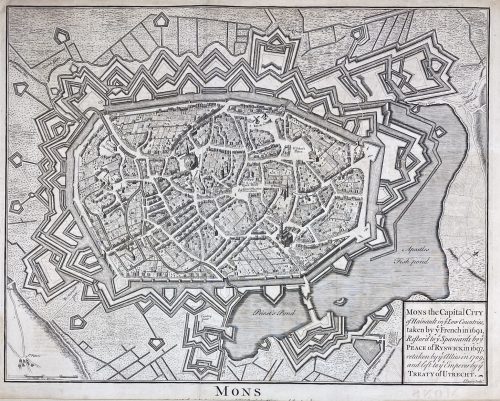
Mons the Capital City of Hainault in y Low Countries, taken by y French in 1691, Restor'd to y Spaniards by y Peace of Ryswick in 1697, retaken by y Allies in 1709, and left to y Emperor by y Treaty of Utrecht. attribution to publication source has been trimmed.
Dimensions: Sheet: 40.7 x 52.5 cm; Image: 37.5 x 48 cm. Published between 1744 and 1747. Attribution to publication source has been trimmed. Reference: Royal Academy 03/2919. Source: Maps for Mr. Tindal's Continuation of Mr. Rapin's History of England. London: John and Paul Knapton. Nicolas Tindal (British, 1687 – 1774) – the translator and continuer of the History of England by Paul de Rapin. Paul de Rapin (French, 1661 – 1725) – a Huguenot historian, author of the History of England. -
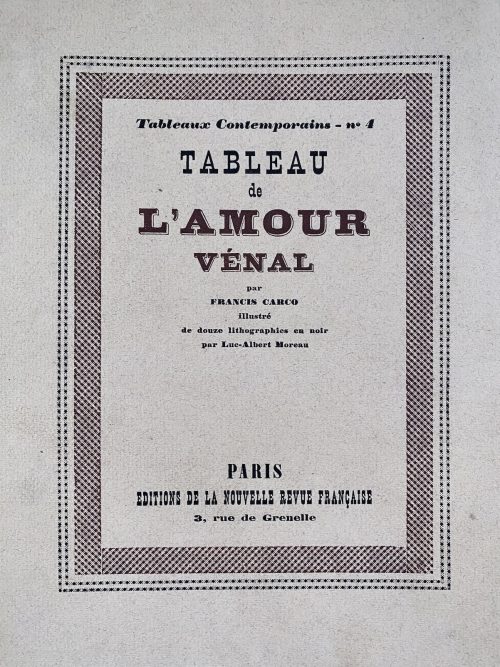 Description: Softcover, French flapped wrappers, lettered front, back (advert.) and spine, collated in-4to, 24.3 x 20.2 cm, printed on thick wove paper Vélin pur fil Lafuma-Navarre, print run limited to 335 copies from which this is copy № 219; outer margin untrimmed, some leaves uncut, glassine DJ. Limitation: 1 copy (A) on Japon Impérial + double suite of plates + suite of original drawings, 4 copies (B-E) on Japon Impérial + double suite of plates, 15 copies on on Japon Impérial + suite of plates on Vieux Japon teinté (F-T), 315 copies on Vélin pur fil Lafuma-Navarre, of which 15 (I-XV) not for sale. Copyright: Libraire Gallimard, 1924. Printed: March 10, 1924 – text by Coulouma (Argenteuil) under direction of H. Barthélemy, lithographs printed by Marchizet (Paris). Front wrapper (in letterpress two-colour border): Tableaux Contemporains – no 4 | . TABLEAU | de | L'AMOUR | VÉNAL | par | FRANCIS CARCO | Illustré | de douze lithographies en noir | par Luc-Albert Moreau | PARIS | ÉDITIONS DE LA NOUVELLE REVUE FRANÇAISE | 3, rue de Grenelle || Title-page: Same, without a frame, in black, L'AMOUR | VÉNAL in brown. Collation: 4to; 14 a4 2-164, total 68 leaves with wrappers included in collation plus 12 plates, incl. frontispiece, extraneous to collation. Pagination: [2 wrapper] [6] [i] ii-vii [viii blank] [9] 10-122 [2 colophon] [2 blank] [2 wrapper]; total 136 pages incl. wrappers, plus ils. Contributors: Francis Carco [François Carcopino-Tusoli] (French, 1886 – 1958) – author. Luc-Albert Moreau (French, 1882 – 1948) – artist. La Nouvelle Revue Française (nrf) (Paris)– publisher. Gaston Gallimard (French, 1881 – 1975) – publisher.
Description: Softcover, French flapped wrappers, lettered front, back (advert.) and spine, collated in-4to, 24.3 x 20.2 cm, printed on thick wove paper Vélin pur fil Lafuma-Navarre, print run limited to 335 copies from which this is copy № 219; outer margin untrimmed, some leaves uncut, glassine DJ. Limitation: 1 copy (A) on Japon Impérial + double suite of plates + suite of original drawings, 4 copies (B-E) on Japon Impérial + double suite of plates, 15 copies on on Japon Impérial + suite of plates on Vieux Japon teinté (F-T), 315 copies on Vélin pur fil Lafuma-Navarre, of which 15 (I-XV) not for sale. Copyright: Libraire Gallimard, 1924. Printed: March 10, 1924 – text by Coulouma (Argenteuil) under direction of H. Barthélemy, lithographs printed by Marchizet (Paris). Front wrapper (in letterpress two-colour border): Tableaux Contemporains – no 4 | . TABLEAU | de | L'AMOUR | VÉNAL | par | FRANCIS CARCO | Illustré | de douze lithographies en noir | par Luc-Albert Moreau | PARIS | ÉDITIONS DE LA NOUVELLE REVUE FRANÇAISE | 3, rue de Grenelle || Title-page: Same, without a frame, in black, L'AMOUR | VÉNAL in brown. Collation: 4to; 14 a4 2-164, total 68 leaves with wrappers included in collation plus 12 plates, incl. frontispiece, extraneous to collation. Pagination: [2 wrapper] [6] [i] ii-vii [viii blank] [9] 10-122 [2 colophon] [2 blank] [2 wrapper]; total 136 pages incl. wrappers, plus ils. Contributors: Francis Carco [François Carcopino-Tusoli] (French, 1886 – 1958) – author. Luc-Albert Moreau (French, 1882 – 1948) – artist. La Nouvelle Revue Française (nrf) (Paris)– publisher. Gaston Gallimard (French, 1881 – 1975) – publisher. -
 Kominato in Awa province [Awa Kominato] – one of five fan prints in the series Famous places in the Bōsō peninsula [Bōsō meisho], devoted to the trip undertaken by Hiroshige in 1852 to Bōsō peninsula (present-day Chiba prefecture). “Two fashionably dressed women beside the veranda of a wayside inn gaze out over Uchiura Bay toward the Tanjō Temple on the far shore, as a boat sets out to the sea from the fishing hamlet of Kominato. …Hiroshige’s viewpoint is from the lower slopes of Mount Kiyosumi”. Ref: Sebastian Izzard. Important Japanese Prints 1830–1860 March 14–20, 2020 exhibition [LIB-2398.2020], №. 52. Not in Faulkner's Hiroshige Fan Prints. Artist: Utagawa Hiroshige [歌川 広重] a.k.a. Andō Hiroshige [安藤 広重] (Japanese, 1797 – 1858). Publisher: Tsujiya Yasubei [辻屋安兵衛] Kinkaido [錦魁堂] (Japanese, c. 1842 – 1863) Date seal and double nanushi censor seal: Mera & Watanabe; Kaei 5, 11th month (1852). Signed: Hiroshige ga [広重 画] in a red cartouche. Size: Fan print (Aiban yoko-e uchiwa-e); 225 x 292 mm.
Kominato in Awa province [Awa Kominato] – one of five fan prints in the series Famous places in the Bōsō peninsula [Bōsō meisho], devoted to the trip undertaken by Hiroshige in 1852 to Bōsō peninsula (present-day Chiba prefecture). “Two fashionably dressed women beside the veranda of a wayside inn gaze out over Uchiura Bay toward the Tanjō Temple on the far shore, as a boat sets out to the sea from the fishing hamlet of Kominato. …Hiroshige’s viewpoint is from the lower slopes of Mount Kiyosumi”. Ref: Sebastian Izzard. Important Japanese Prints 1830–1860 March 14–20, 2020 exhibition [LIB-2398.2020], №. 52. Not in Faulkner's Hiroshige Fan Prints. Artist: Utagawa Hiroshige [歌川 広重] a.k.a. Andō Hiroshige [安藤 広重] (Japanese, 1797 – 1858). Publisher: Tsujiya Yasubei [辻屋安兵衛] Kinkaido [錦魁堂] (Japanese, c. 1842 – 1863) Date seal and double nanushi censor seal: Mera & Watanabe; Kaei 5, 11th month (1852). Signed: Hiroshige ga [広重 画] in a red cartouche. Size: Fan print (Aiban yoko-e uchiwa-e); 225 x 292 mm. -
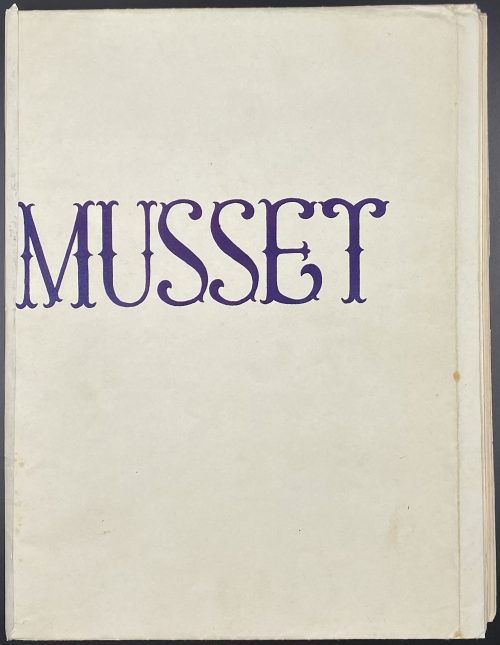 Description: one volume in French flapped wrappers 25.3 x 19 cm, lettered “MUSSET” to front, 5 gatherings of 4 and one of 6 leaves, 26 leaves total, pp.: [4] [2] 3-43 [44] [4], total 52 pages, incl. those in wrappers, unbound; plus coloured and uncoloured suites of 12 lithographs, in a paper folder; in a cardboard tan slipcase 2.8 x 19.3 cm. Artist unknown, publisher unknown, published at the end of 1940s (per J.-P. Dutel). Illustrations are a loose interpretation of original lithographs by Devéria and Henri Grévedon or Octave Tassaert for the 1833 edition ((1926 re-print LIB-3135.2023). Limitation: Edition limited to 250 copies printed on Vélin Chiffon numbered 1 -250 and 24 copies marked by letters A to Z. This is copy № 246, with two suites of plates, one coloured and one b/w. Catalogue raisonné: Dutel (1920-1970) № 1657, p. 189. Alfred de Musset (French, 1810 – 1857) – author.
Description: one volume in French flapped wrappers 25.3 x 19 cm, lettered “MUSSET” to front, 5 gatherings of 4 and one of 6 leaves, 26 leaves total, pp.: [4] [2] 3-43 [44] [4], total 52 pages, incl. those in wrappers, unbound; plus coloured and uncoloured suites of 12 lithographs, in a paper folder; in a cardboard tan slipcase 2.8 x 19.3 cm. Artist unknown, publisher unknown, published at the end of 1940s (per J.-P. Dutel). Illustrations are a loose interpretation of original lithographs by Devéria and Henri Grévedon or Octave Tassaert for the 1833 edition ((1926 re-print LIB-3135.2023). Limitation: Edition limited to 250 copies printed on Vélin Chiffon numbered 1 -250 and 24 copies marked by letters A to Z. This is copy № 246, with two suites of plates, one coloured and one b/w. Catalogue raisonné: Dutel (1920-1970) № 1657, p. 189. Alfred de Musset (French, 1810 – 1857) – author. -
 Artist (attributed, no signature): Suzuki Harunobu [鈴木 春信] (Japanese, c. 1725 – 1770). The title is taken from [LIB-1478.2013] Gian Carlo Calza, Stefania Piotti. Poem of the pillow and other stories. — Phaidon Press, 2010; pp. 148-9. Alternative title: Man sucking woman's breast and a cat sitting under a bonsai tree. The open book beside the couple reads 子春 (Koharu). Woodblock print from the series Mirror Picture of Japan (Wakoku kagami); Size: Horizontal chuban; 21 x 26 cm.
Artist (attributed, no signature): Suzuki Harunobu [鈴木 春信] (Japanese, c. 1725 – 1770). The title is taken from [LIB-1478.2013] Gian Carlo Calza, Stefania Piotti. Poem of the pillow and other stories. — Phaidon Press, 2010; pp. 148-9. Alternative title: Man sucking woman's breast and a cat sitting under a bonsai tree. The open book beside the couple reads 子春 (Koharu). Woodblock print from the series Mirror Picture of Japan (Wakoku kagami); Size: Horizontal chuban; 21 x 26 cm. -
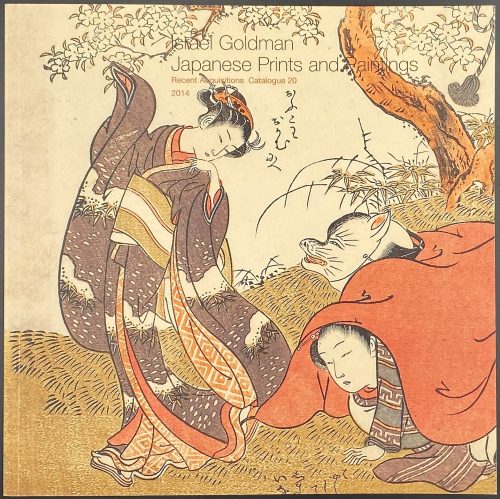 Softcover, pictorial wrappers, square 21 x 21 cm, 40 leaves, unpaginated, with illustrations in colour, 77 entries, with price list laid in; limited edition of 700 copies. Contributor: Israel Goldman Prints in this collection:
Softcover, pictorial wrappers, square 21 x 21 cm, 40 leaves, unpaginated, with illustrations in colour, 77 entries, with price list laid in; limited edition of 700 copies. Contributor: Israel Goldman Prints in this collection:![Isoda Koryūsai . Prosperous Flowers of the Elegant Twelve Seasons: young couple making love while older man sleeps. [Shunga]. 1773](http://varshavskycollection.com/wp-content/uploads/2020/12/SVJP200039.2015-400x288.jpeg)
SVJP-0039.2015: Isoda Koryūsai. Kikuzuki (the ninth month) from the series Furyu juniki no eiga (Prosperous flowers of the elegant twelve months) / Chuban, early 1770s; #7 in the catalogue.
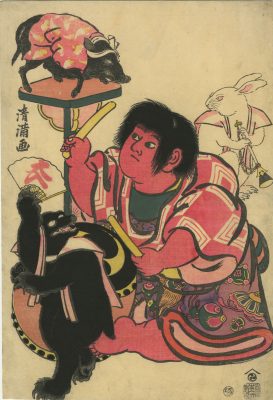
SVJP-0180.2014: Torii Kiyomitsu II. Kintaro with a boar, rabbit, and tanuki / Oban, c. 1805; # 15 in the catalogue.
-
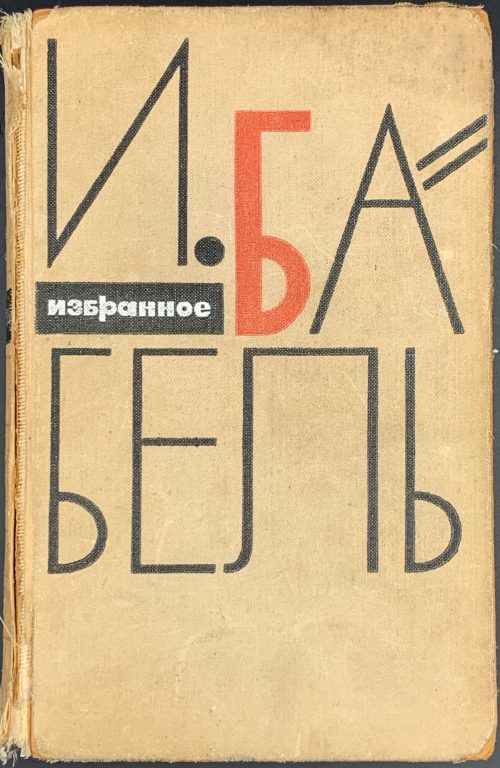 Description: one volume, 20.7 x 13.3 cm, bound in cream cloth with red and black lettering to front cover and spine, author’s photographic portrait frontispiece. Title-page (black and red): ИЗБРАННОЕ (vertical, red) | И. БАБЕЛЬ | {publisher’s device “ИХЛ”} | Издательство | «ХУДОЖЕСТВЕННАЯ ЛИТЕРАТУРА» | Москва | 1966 || Contents: Конармия; Одесские рассказы; Рассказы; Воспоминания; Пьесы; Статьи, выступления; Письма; Комментарии. Imprint: Вступительная статья | Л. ПОЛЯК | Комментарии | Е. КРАСНОЩЕКОВОЙ | Оформление художника | Ю. БОЯРСКОГО | 7–3–2 / 57–66 || Pagination :[2] 3-493 [494] [2]; total 496 pages, ils. Collation: 8vo; [1]-318; total 248 leaves plus author’s photographic portrait frontispiece. Contributors: Исаак Эммануилович Бабель [Isaac Babel] (Russian-Jewish, 1894 – 1940) – author. Лидия Моисеевна Поляк (Russian-Jewish, 1899 – 1992) – author, foreword. Елена Александровна Краснощекова (Russian-Jewish, b. 1934) (see Александр Михайлович Краснощёков) – author, commentary. Юлий Александрович Боярский (Russian, 1924 – 2009) – artist.
Description: one volume, 20.7 x 13.3 cm, bound in cream cloth with red and black lettering to front cover and spine, author’s photographic portrait frontispiece. Title-page (black and red): ИЗБРАННОЕ (vertical, red) | И. БАБЕЛЬ | {publisher’s device “ИХЛ”} | Издательство | «ХУДОЖЕСТВЕННАЯ ЛИТЕРАТУРА» | Москва | 1966 || Contents: Конармия; Одесские рассказы; Рассказы; Воспоминания; Пьесы; Статьи, выступления; Письма; Комментарии. Imprint: Вступительная статья | Л. ПОЛЯК | Комментарии | Е. КРАСНОЩЕКОВОЙ | Оформление художника | Ю. БОЯРСКОГО | 7–3–2 / 57–66 || Pagination :[2] 3-493 [494] [2]; total 496 pages, ils. Collation: 8vo; [1]-318; total 248 leaves plus author’s photographic portrait frontispiece. Contributors: Исаак Эммануилович Бабель [Isaac Babel] (Russian-Jewish, 1894 – 1940) – author. Лидия Моисеевна Поляк (Russian-Jewish, 1899 – 1992) – author, foreword. Елена Александровна Краснощекова (Russian-Jewish, b. 1934) (see Александр Михайлович Краснощёков) – author, commentary. Юлий Александрович Боярский (Russian, 1924 – 2009) – artist. -
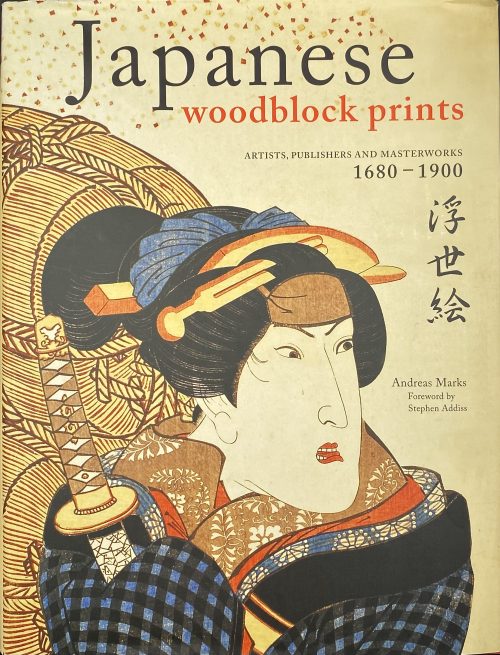 Hardcover, 31 x 24 cm, red paper with black and white lettering to front cover and spine, pictorial endpapers, pictorial dust jacket; pp.: [1-8] 9-336, profusely illustrated in colour. Title-page (black and red): Japanese | woodblock prints | ARTISTS, PUBLISHERS AND MASTERWORKS | 1680 – 1900 | Andreas Marks {|} Foreword by Stephen Addiss | TUTTLE PUBLISHING | Tokyo • Rutland, Vermont • Singapore ||
Hardcover, 31 x 24 cm, red paper with black and white lettering to front cover and spine, pictorial endpapers, pictorial dust jacket; pp.: [1-8] 9-336, profusely illustrated in colour. Title-page (black and red): Japanese | woodblock prints | ARTISTS, PUBLISHERS AND MASTERWORKS | 1680 – 1900 | Andreas Marks {|} Foreword by Stephen Addiss | TUTTLE PUBLISHING | Tokyo • Rutland, Vermont • Singapore ||


